The DCSWCD CSBI program helps landowners by planting Catskill native trees and shrubs in order to improve their streamside habitat and protect their stream and water quality.
For more info about the program contact Program Coordinator Catherine Skalda at 607-865-5223 or catherine-skalda@dcswcd.org.
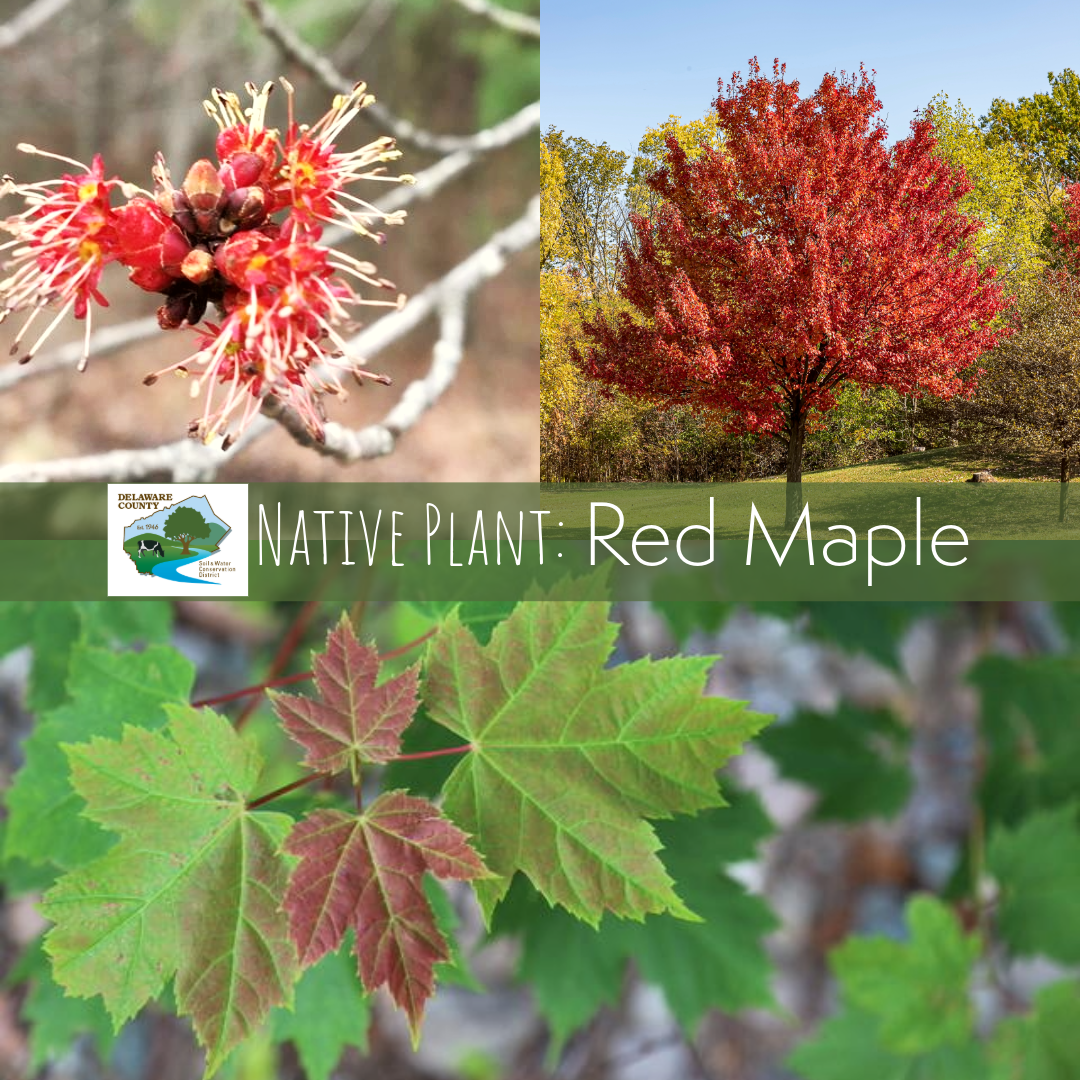
Red Maple (Acer rubrum) is native to Central and Eastern US and Canada, and is one of the most common and widespread deciduous trees in its territory. A fast growing, medium tree, red maple tolerates a wide range of soil and moisture conditions. Reaching up to 100 feet in height, it can grow in spots of full sun to full shade.
Red flowers in early spring, red leafstalks in summer, brilliant red foliage in fall, and red buds in winter give this common tree its name. A valuable wildlife species, red maple is often browsed by large and small mammals and is especially important to deer in late fall and early winter. It is an important in the spring for many insects, especially bees looking for an early pollen source. Equally as important, it supports nearly 300 species of caterpillars which are a critical source of food for many bird species.
Red Maples are also commonly referred to as Soft Maple, Water Maple, or Swamp Maple. A striking tree year-round with high wildlife value, red maple is an excellent tree to add to your landscape.
Photo of red maple flowers CC Mark / inaturalist.org.
The well-known sugar maple, Acer saccharum, is a large hardwood tree native to eastern Canada and the eastern United States. Human populations have used this tree’s sap to produce maple syrup for centuries, along with using its wood for lumber and firewood. Sugar maples are also important for wildlife, particularly white-tailed deer, moose, snowshoe hare, porcupine, and squirrels who browse the leaves and bark along with the seeds, buds, and twigs. The lush deciduous canopy, trunk, and branches provide homes for cavity nesters, songbirds, and woodpeckers.
Preferring relatively moist, well-drained soils, sugar maples are found across Delaware County, turning the hillsides into brilliant autumn shows of reds, yellows and oranges. Critical to the hardwood forest ecosystem, sugar maples provide an abundance of ecological benefits. These shallow, yet fibrous and wide rooted trees hold soil and nutrients in place which reduces runoff into nearby waterways. Fallen leaves also provide an important nutrient source for forests, while leaved branches shade the soil providing a cooling effect and carbon sink.
When deciding which maple to plant in your landscape, consider choosing a native maple such as the sugar maple. Nonnative and invasive maples can outcompete native maples threatening the survival of native maples and the wildlife that depends on them.
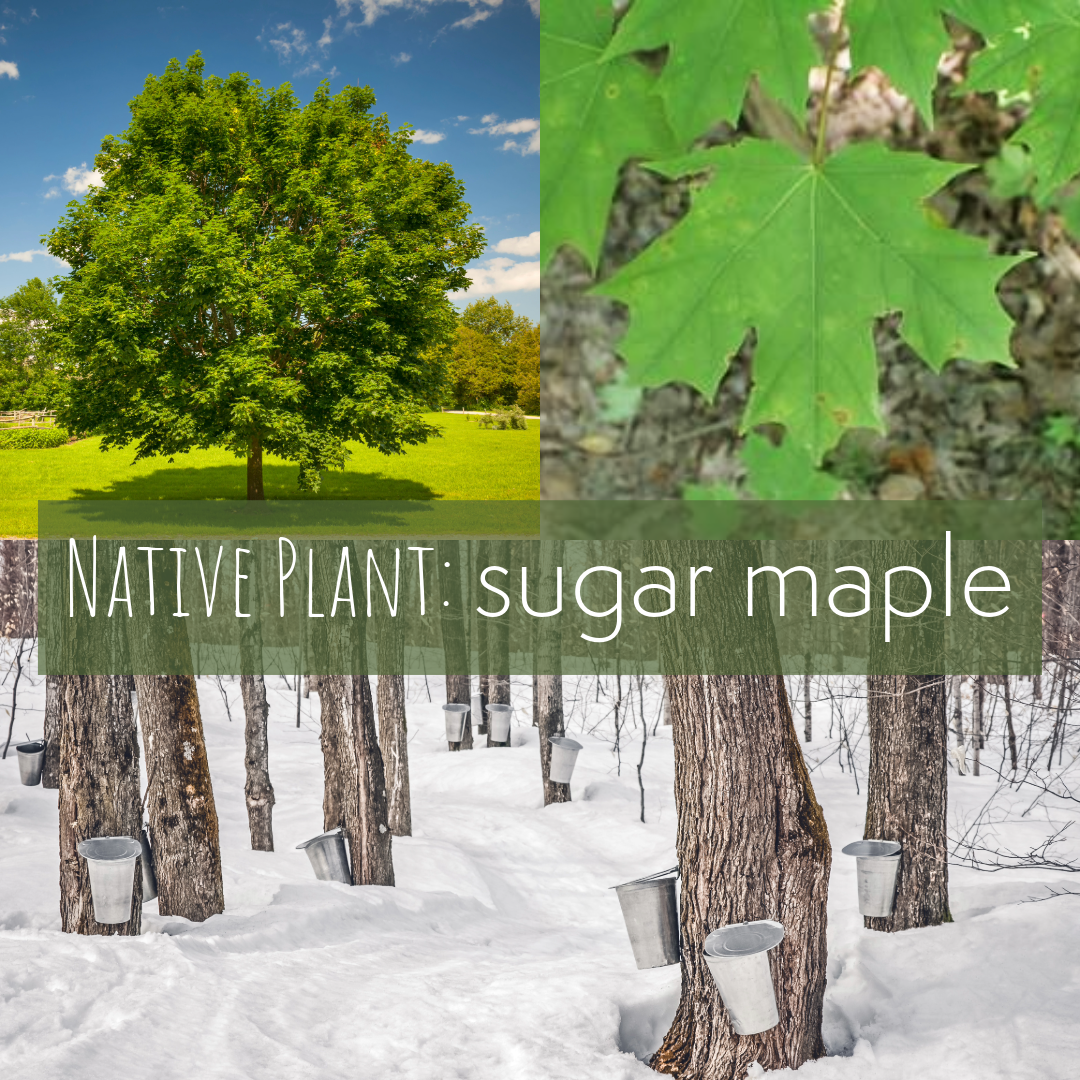
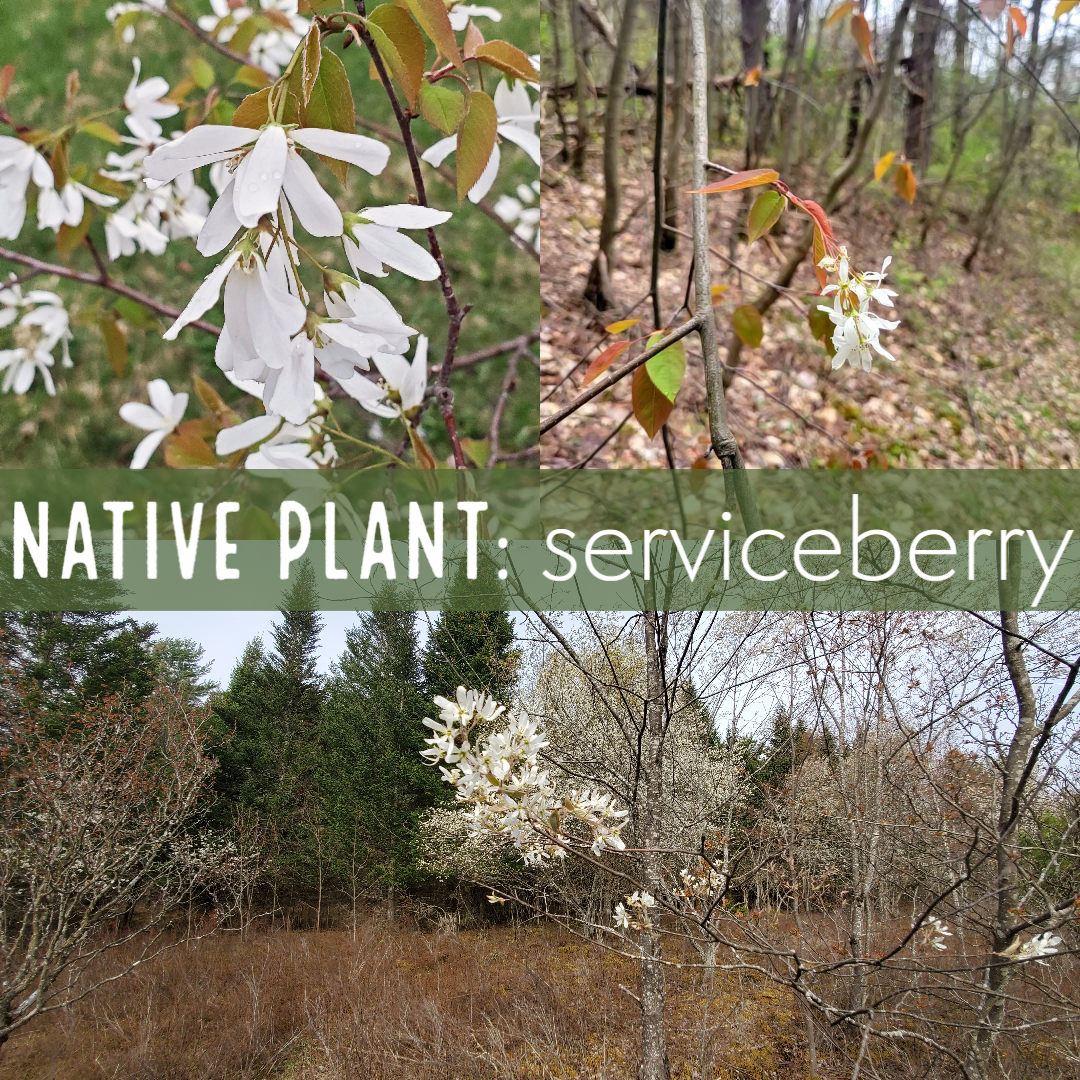
The month of May ushers in the blooms of Amelanchier, a native tree also known as serviceberry, juneberry, and shadbush. Delaware County is home to three species: Amelanchier arborea, Amelanchier laevis, and Amelanchier canadensis, all of which are important for pollinators and wildlife. Their mid-spring flowers are important sources of pollen, while their purple June berries provide food for wildlife including songbirds and small mammals. The shrub-like tree offers good nesting sites for American robins, and it is a host plant for coral hairstreak butterfly.
Along with its many wildlife benefits, Amelanchier is an excellent landscape plant. It is one of the earliest flowering native trees and has a lovely orange fall color. This mid-sized tree can reach a height of 15-25 feet and prefers upland sites in full to partial sun with acidic soil. Hardy from zones 4 to 8, Amelanchier is well suited to the eastern U.S. and Canada.
Aronia melanocarpa, commonly known as Black Chokeberry, is a shrub native to Central and Eastern US and Canada across hardiness zones 3 to 8. Preferring full sun to partial shade and acidic soils, the shrub is flood tolerant with an ability to withstand wet conditions along ponds and streams.
A beautiful shrub in all seasons, Black Chokeberry has a high wildlife value. In late spring, nectar from its clusters of white flowers attract bees, butterflies, and birds. Flowers give way to lustrous black fruits, slightly larger than black currants, which are eaten by many species of birds including the Ruffed grouse and Cedar Waxwing, as well as mammals such as red fox, black bear, raccoon, opossum, squirrels, and rabbits. As the season progresses, the shrub’s deciduous leaves become bright yellow, orange, or red during the fall.
Rose-lovers, rejoice! Black Chokeberry is one of the spring-flowering shrubs of the Rose family that most people are unfamiliar with. It remains small in size and lacks thorns, yet produces an abundance of beautiful rose flowers, clusters of black berries, and gorgeous fall foliage. A great native option when choosing landscape plants, DCSWCD plants Black Chokeberry frequently in our riparian buffer plantings because of its high wildlife value and light, soil, and moisture preferences.
Images: missouribotanicalgarden.org
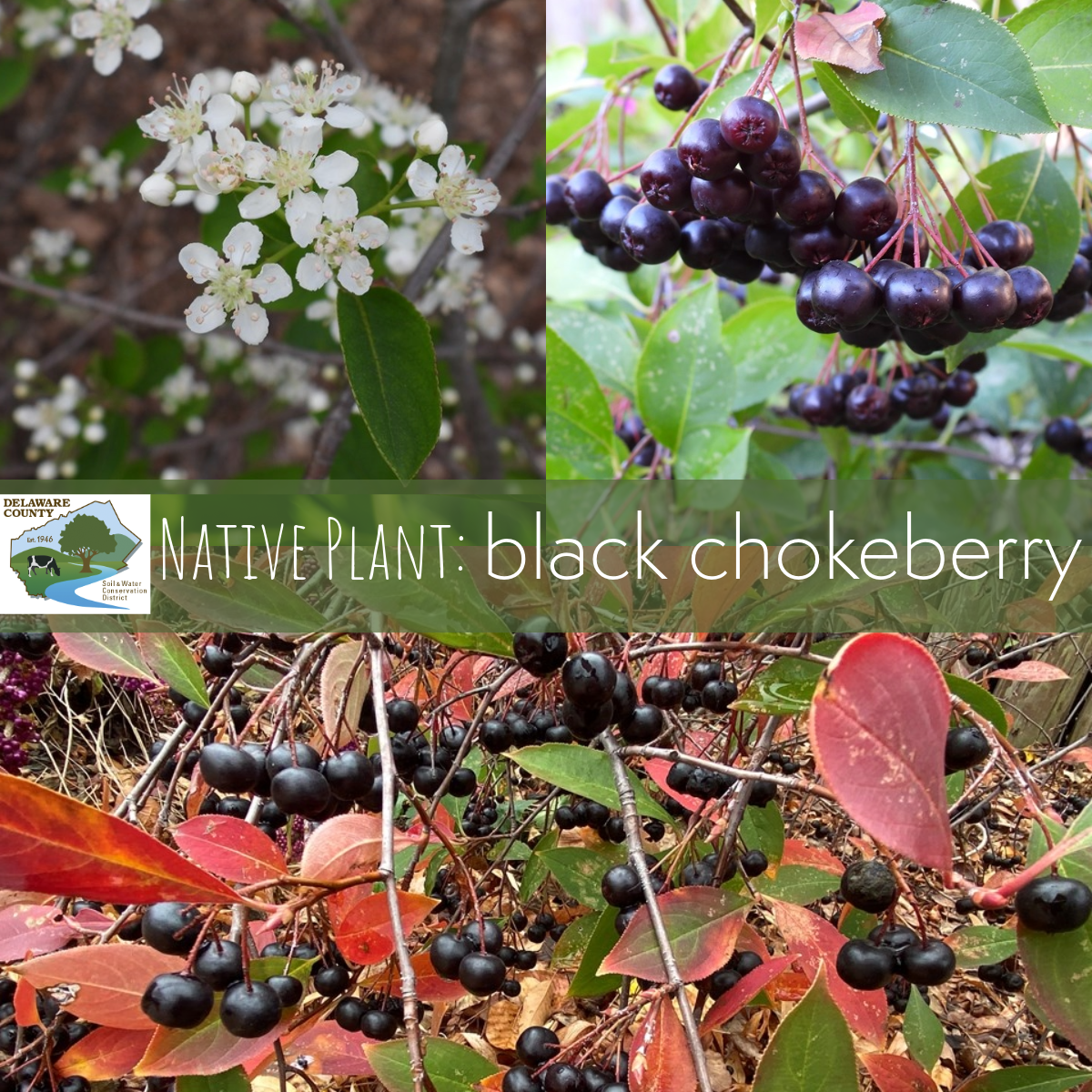
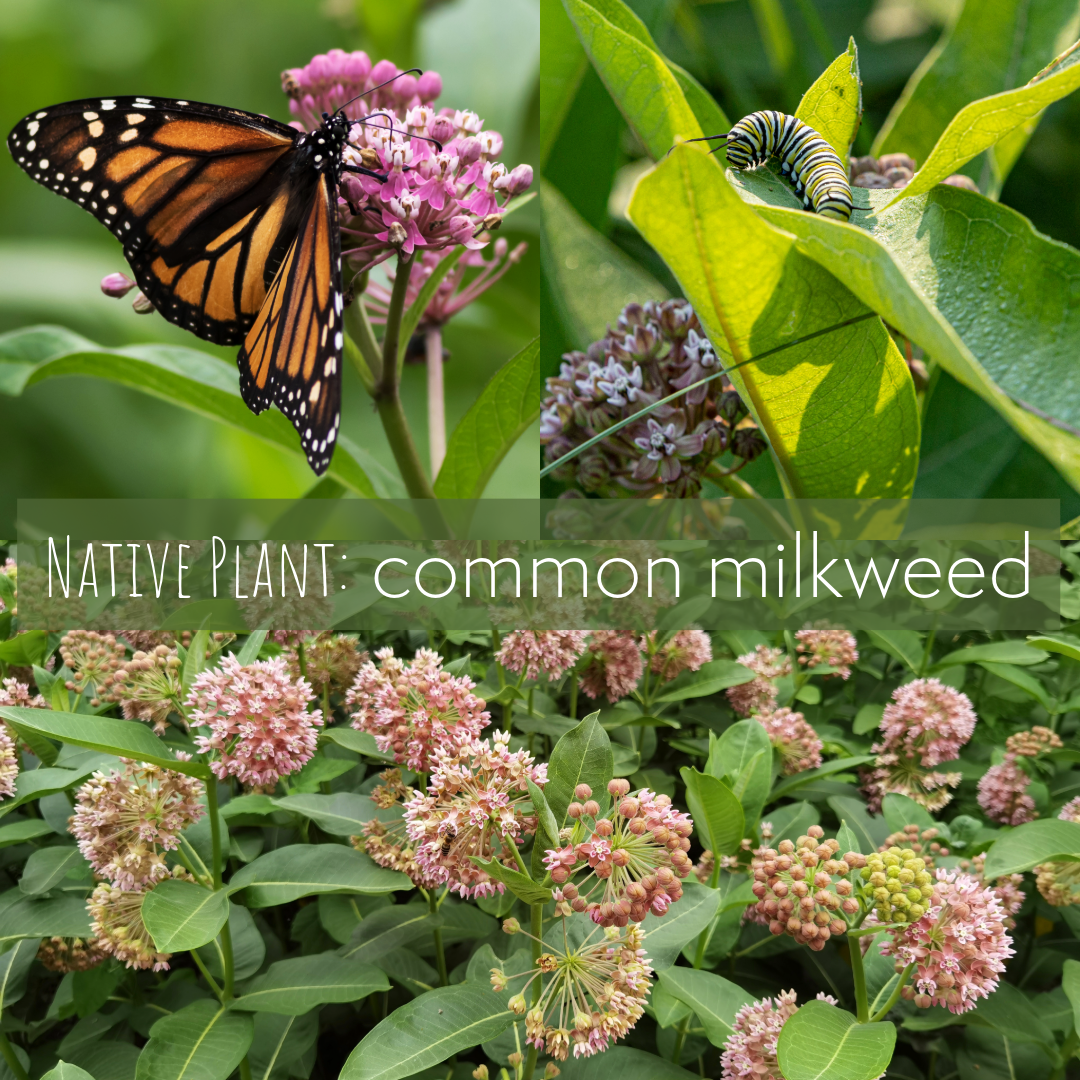
There are several types of milkweed (Asclepiadaceae family) native to Delaware County. The most commonly seen are common milkweed (Asclepias syriaca), butterfly weed (Asclepias tuberosa), swamp milkweed (Asclepias incarnata), and whorled milkweed (Asclepias verticillata). Common milkweed is…most common! It’s pink to light purple flower clusters bloom in July and August atop tubular stems that can reach a height of five feet. And the scent is absolutely divine!
Common milkweed is a GREAT plant for insects, attracting over 450 species that feed on all parts of the plant. These include numerous native pollinators such as flies, beetles, ants, bees, wasps, and butterflies. Milkweed is best known for attracting monarch butterflies which consume the nectar and are the exclusive host plant for monarch caterpillars. Milkweed is also a host to the milkweed tussock moth caterpillars which is one of the few insects which can also eat the leaves of the plant. Another insect that is commonly seen on milkweeds is the bright orange and black Milkweed bug (there is both a large and small species of these bugs). They feed on the sap and seeds of the plants, but don’t worry, the bugs do little to damage the milkweed plants.
A strikingly beautiful plant, common milkweed is an excellent addition to gardens and landscapes. Spreading through both seeds and rhizomes, colonies can become established rather quickly in full sun areas. The flower clusters transition to pods containing 50-100 seeds per pod, which eventually split to release the brown seeds attached to downy white fluff furthering their dispersal through wind.
Betula alleghaniensis, commonly known as Yellow Birch, has showy, yellowish-bronze exfoliating bark that when scraped smells of wintergreen! Slow growing, yet long-lived, this hardwood is native to the eastern U.S. and Canada preferring moist, well-drained soils along streams and swampy woodlands with full to part sun.
Yellow Birch is a preferred food of the snowshoe hare and the white-tailed deer, including its sprouts, seedlings, green leaves, and woody stems. Moose, porcupine, red squirrel, and beaver also enjoy feeding on various parts of the tree. Its prolific seeds are eaten by various songbird species and ruffed grouse who also eat its catkins and buds. Yellow Birch is also a favorite food source of the yellow-bellied sapsucker. It serves as a host plant for over 300 species of butterflies and moths, including the Mourning Cloak and Red-spotted Admiral butterflies and the beautiful Polyphemus moth, whose wingspan can reach 6 inches in size.
Yellow Birch also makes a beautiful landscape addition with its showy bark and yellow-orange fall foliage.
Green leaf photo source: inaturalist.org
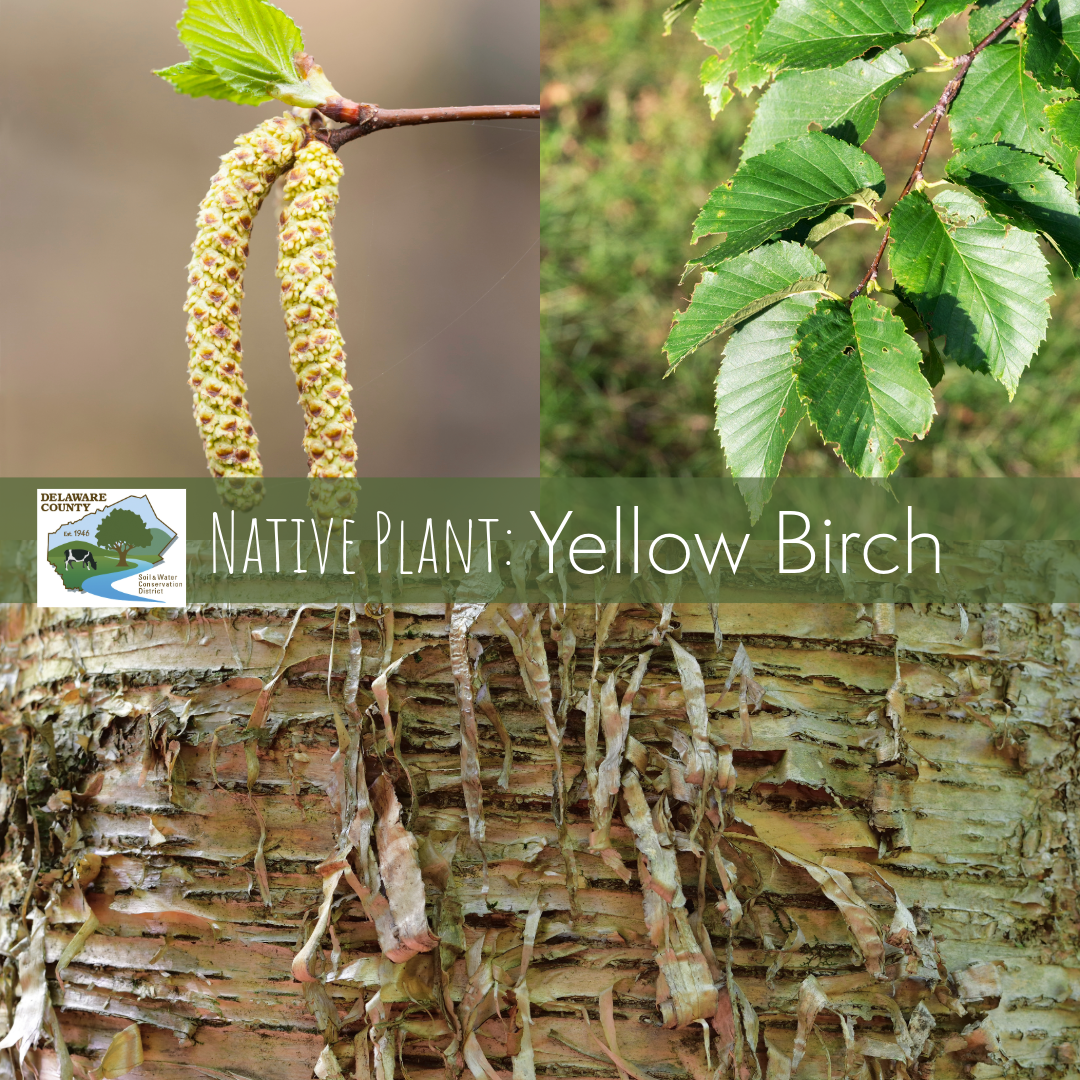
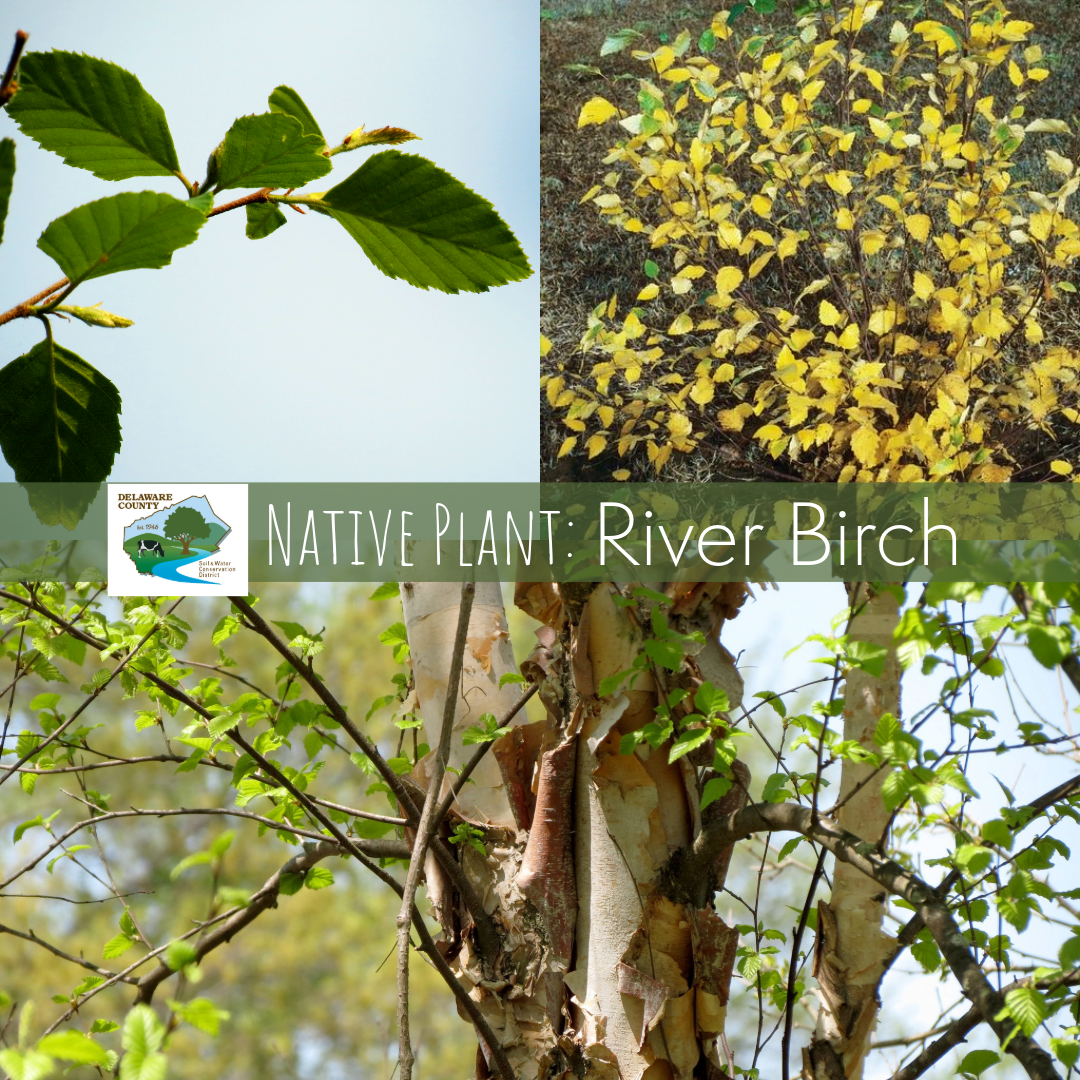
River Birch (Betula nigra) is wonderful native tree that you can find in the Midwest and Eastern United States. It requires full sun thrives in moist, acidic soils, often found along stream banks and in swampy bottomlands that are periodically flooded. This tree is a fantastic choice for riparian buffers throughout its range, especially when paired with companion species.
River Birch provides food and habitat to numerous wildlife species year-round. Its young twigs, buds and foliage are browsed by white-tailed deer and moose, and its seeds, buds, and catkins are eaten by grouse, turkeys and birds. The inner bark is sometimes eaten by porcupines, while yellow bellied sapsuckers enjoy its sap.
The fast-growing and long-lived River Birch has a distinctive cream and cinnamon-brown colored exfoliating bark, reaching heights of up to 70 feet. A tree with plenty of striking features and wildlife benefits, River Birch makes an excellent landscape plant for locations in which other species may struggle.
Image of yellow leaves John Ruter, University of Georgia, Bugwood.org.
Images of bark and green leaves CC Katja Schulz / Flickr.
Betula papyrifera, commonly known as White Paper Birch, Paper Birch, or Canoe Birch, is a striking tree native to the northern United States and Canada. Preferring moderately moist, acidic sites and a range of light from sun to shade, the species thrives in hardiness zones 2 to 6.
One of the more easily identifiable trees, White Paper Birch’s name is indicative of its white bark that appears to shed papery bark pieces. The white bark is complemented by brilliant yellow fall foliage making the medium-sized tree an all-around great choice for ornamental plantings.
White Paper Birch has high wildlife value. Its seeds, buds, and catkins are eaten by birds and small mammals and its inner bark is eaten by porcupines. The tree is also a sap source for yellow bellied sapsuckers and larval and/or nectar source for the gorgeous Luna moth and Eastern Tiger Swallowtail butterfly. Paper Birch provides browse material and cover for deer and, for our northern neighbors, moose.
📸 of leaves: aarongunnar – bplant.org
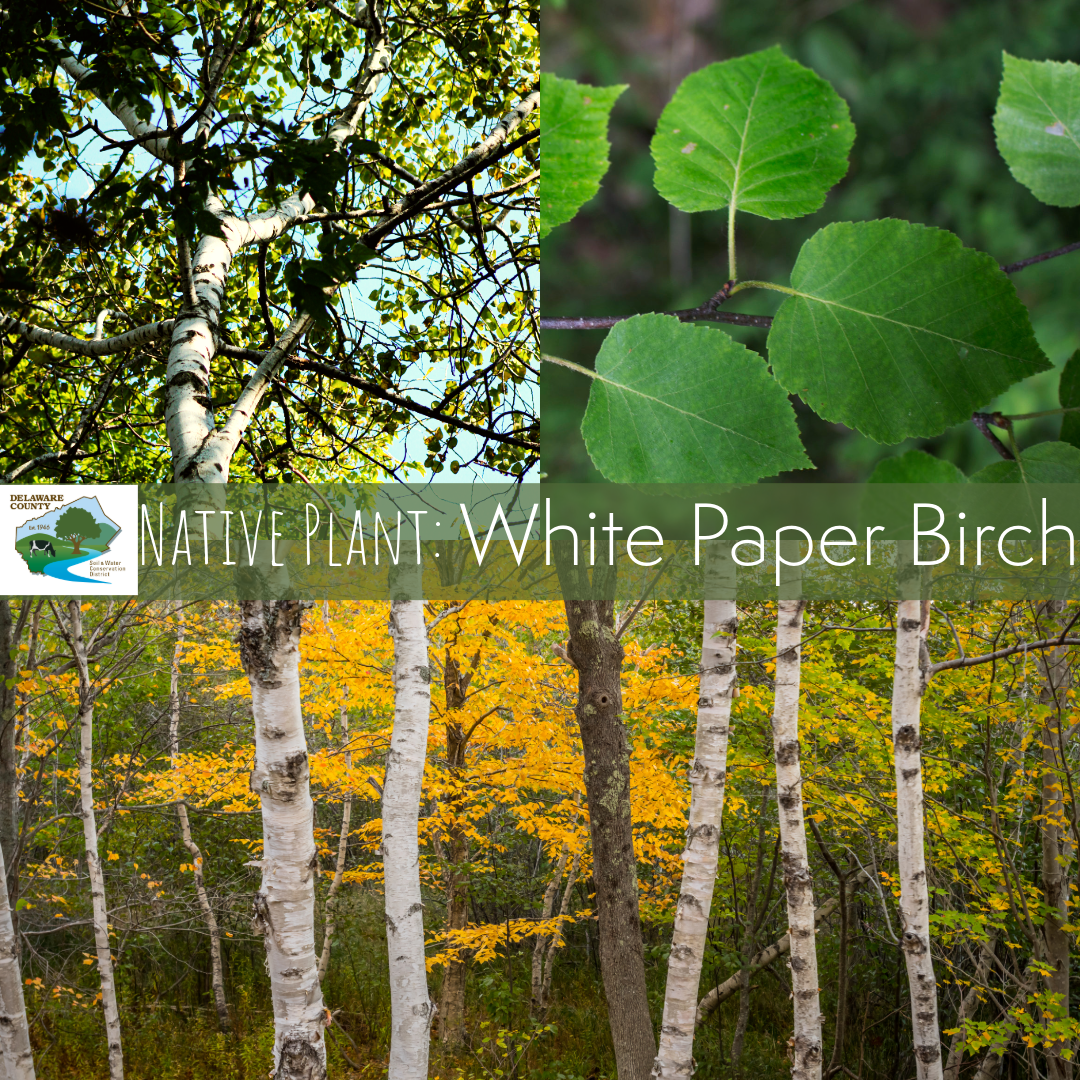
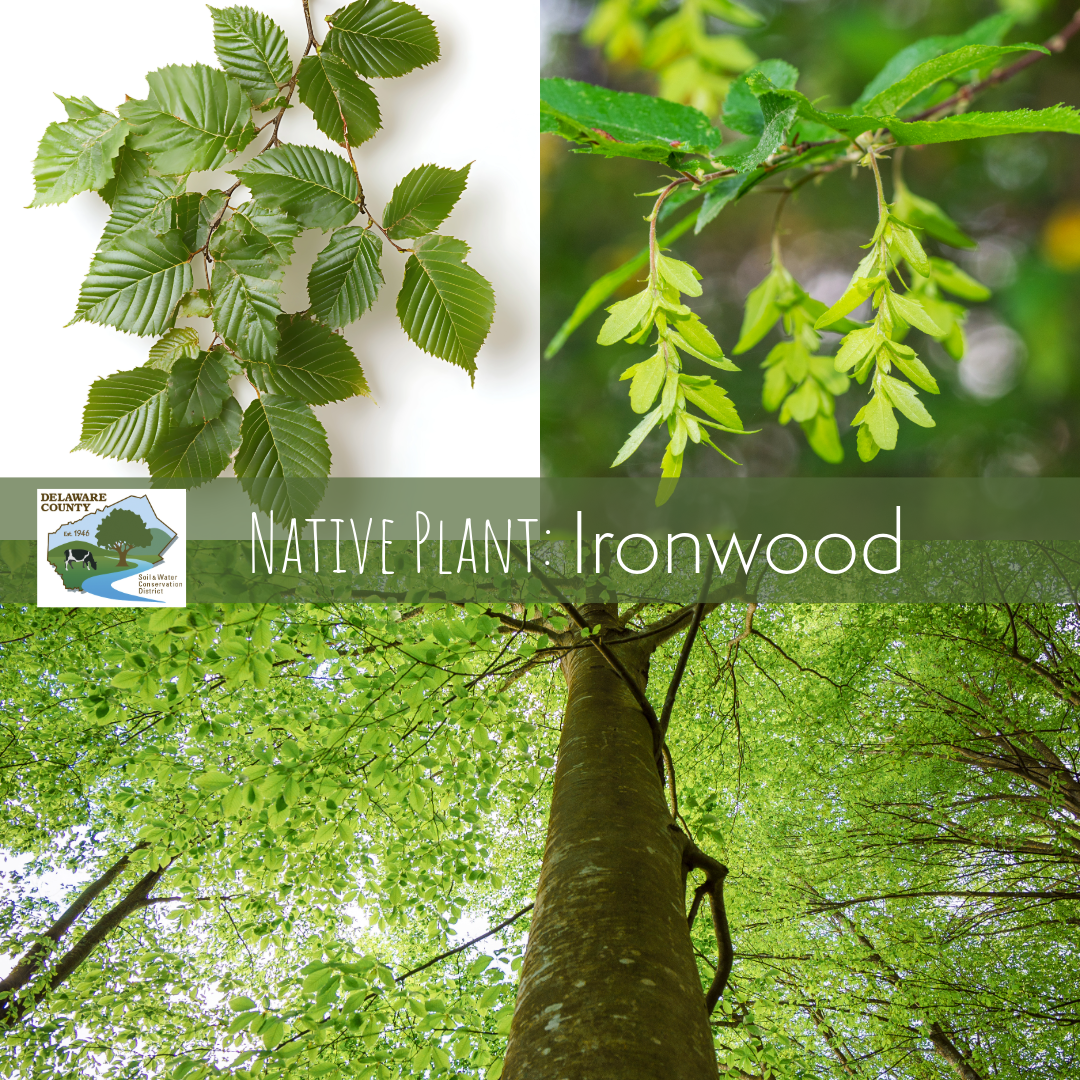
Carpinus caroliniana, commonly known as Ironwood or American Hornbeam, has a native range that stretches across Eastern North America’s plant hardiness zones 3 to 9. As its name implies, Ironwood is a hardwood species that prefers shaded, rich, moist soils in forests, valleys, bottomland, floodplains, and along streams.
The medium-sized tree reaches heights of approximately 25’, tolerating partial to full shade. Winged nutlets follow catkins, which are eaten by grouse and other birds, as well as deer and small mammals. Its thin, smooth, gray bark has a muscular appearance, and it is also sometimes referred to by the common name of musclewood.
While slow growing, with patience Ironwood is a good landscape and street tree choice as it’s native, medium-sized, and relatively hardy. In the fall, its oval, serrated leaves turn a showy yellow, orange, and red. Historically, Ironwood’s extremely hard wood was used by early Americans to make bowls, tool handles and ox yokes which could be polished to a horn-like appearance.
Cephalanthus occidentalis, commonly known as buttonbush, is native to the mid- and eastern United States and Canada. It prefers full to partial sun in hardiness zones 4 to 10. It is one of the most flood-tolerant shrubs and grows at the water’s edge, in wetlands, and even in standing water. This plant is also commonly used in our riparian buffer planting and restoration programs.
This beautiful, multi-stemmed native shrub grows to a mature height of 6 to 12 feet. Its dark green, glossy leaves provide a stunning backdrop for the beautiful, button-like clusters of white flowers that bloom in mid-to-late summer and look just like little pincushions.
Buttonbush is not just pretty; it’s also a crucial native habitat plant! It is host to over 23 butterfly and moth caterpillars and is an excellent nectar source for hummingbirds, butterflies, bees, moths, and other insects. You’re likely to spot the bright blue and orange Virginia ctenucha moth flitting around, along with many lovely butterflies and moths. Plus, wood ducks and mallards enjoy its seeds, and the bush’s dense stems offer essential shelter for young wood ducks.
With its unusual flowers and intriguing seed heads, buttonbush makes a fantastic addition to any native setting.
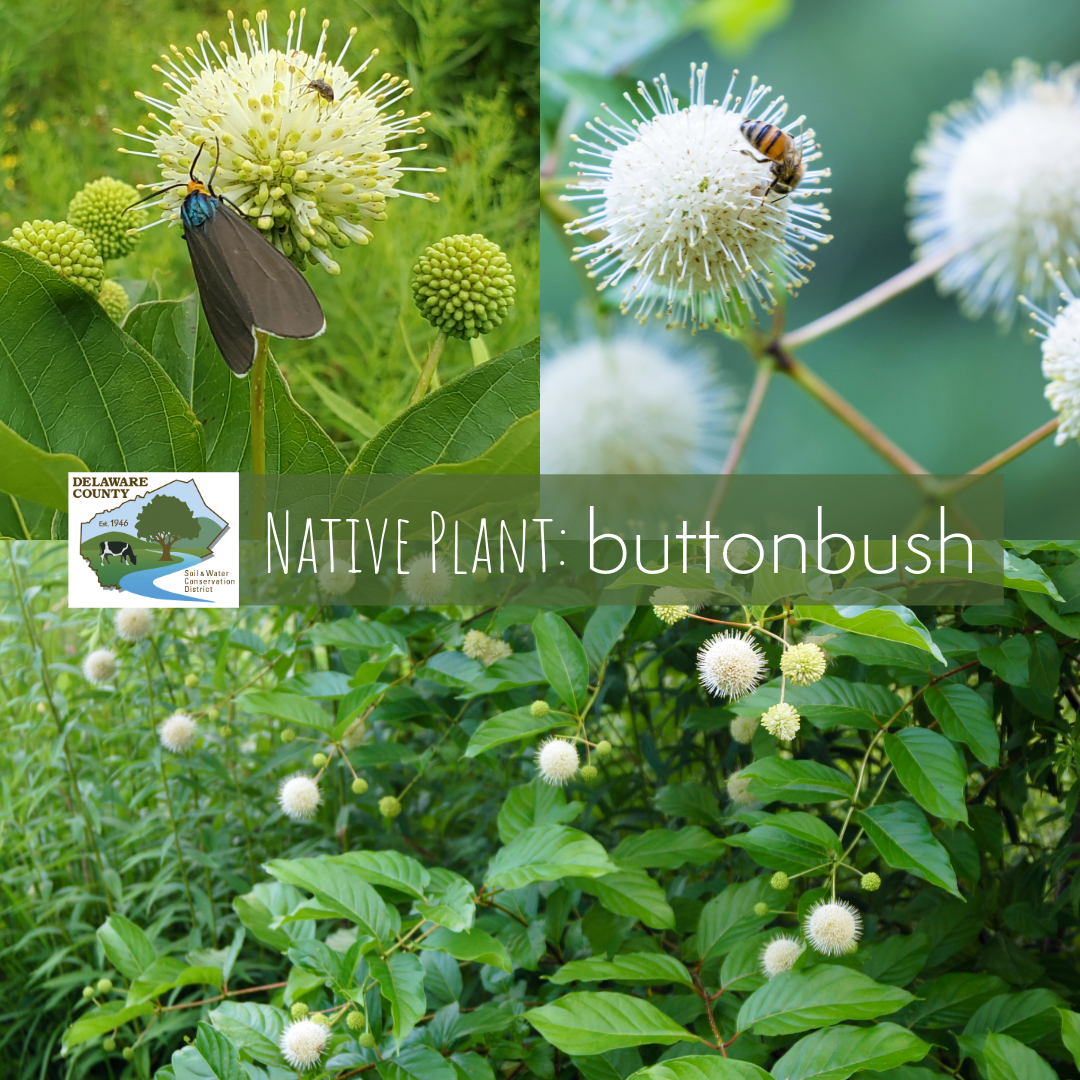
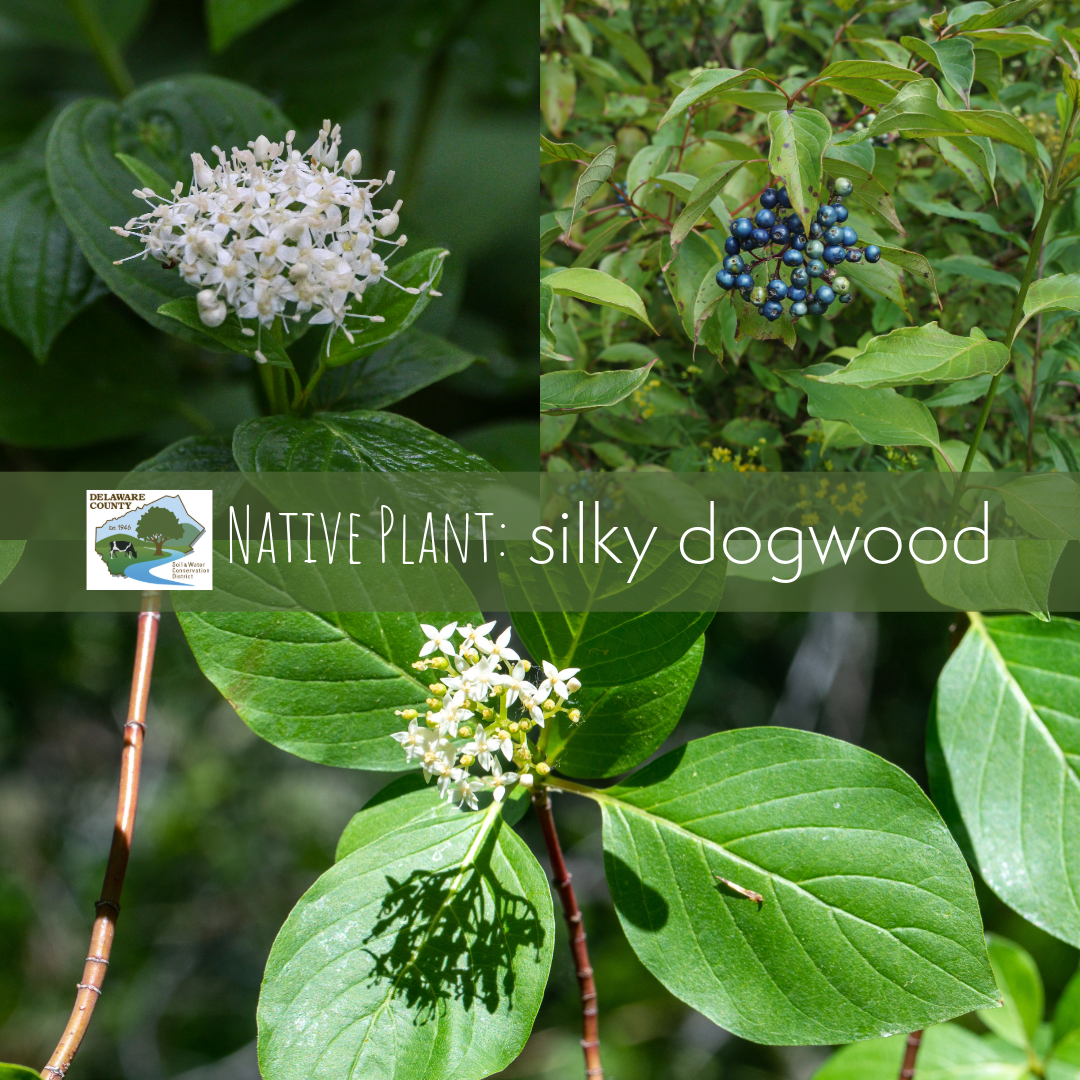
Cornus amomum, commonly known as Silky Dogwood, is native to the Eastern United States preferring wetlands and the water’s edge. Its attractive white flowers in early summer have given way to blue fruits which are a food source for over 90 species of migrating birds – if you have a Silky Dogwood bush on your land, now is the time to birdwatch!
The medium-sized bush reaches three to eight feet in height and is frequently used in streambank restoration projects because of its growing preferences and high wildlife value. While its berries provide food for wildlife, Silky Dogwood’s dense foliage helps shade streams from the hot sun, providing shelter for fish and other wildlife. It is also a host plant for over 125 butterfly and moth species – incredible!
A beautiful, ornamental bush, Silky Dogwood is an excellent landscape choice. Putting on a show throughout the seasons, with its clustered spring flowers to its bunches of berries, and even to its reddish stems in winter, this native plant is lovely and attracts lots of interesting wildlife.
Red Osier Dogwood (Cornus sericea) is a shrub native to the Catskill region and is adapted to moist riparian and upland sites, growing well along both streams and ponds. The plant’s beautiful red stems are complemented by its green leaves and unique white berries that ripen in the fall. These features make it a striking landscape plant and a favorite amongst ornamental gardeners.
Red Osier Dogwood has a high wildlife value, with its seeds, fruits, flowers, twigs, bark, and leaves all used as food by various species. Many native pollinators are attracted to the delicate spring flowers. The fruits are eaten by at least 36 species of birds, and many mammals, small and large. The bush also provides a good nesting site for birds.
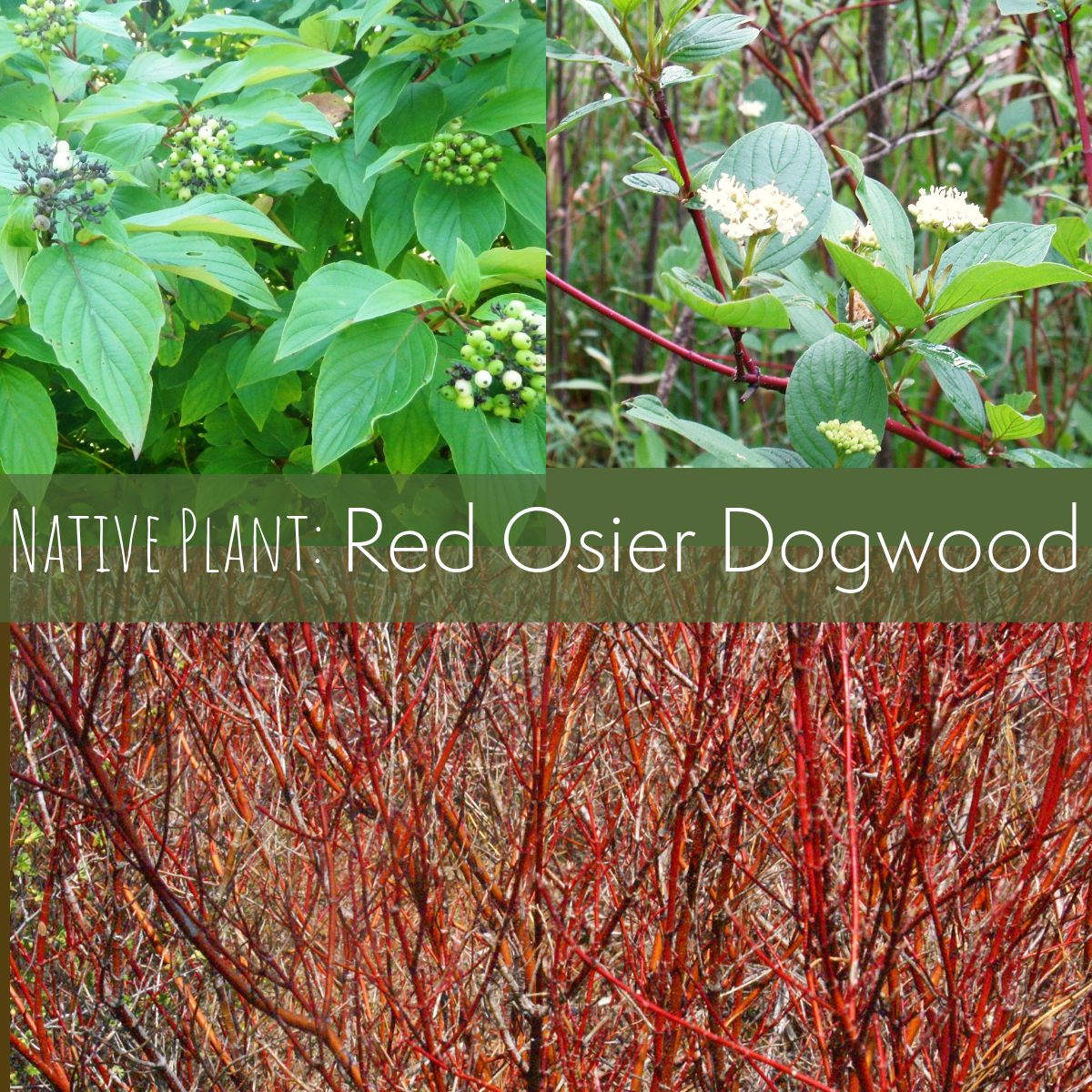

Corylus americana, commonly known as American Hazelnut, is native to the northern U.S. and Canada hardiness zones 4 to 9. Growing best on rich, moist, well-drained soil, but often found close to stream sides, with a wide range of light preference, Hazelnut is found in natural and man-made riparian sites.
Hazelnut provides high wildlife value throughout the seasons, starting in the spring when its buds and catkins provide a valuable protein source for native ruffed grouse and American woodcock. Mid-summer, the flowers mature into egg-shaped, half-inch long nuts that are eaten by squirrels, foxes, deer, northern bobwhite, ruffed grouse, turkey, woodpeckers, pheasants, and deer. It also supports over 140 species of butterflies and moths that use this as a caterpillar host plant. This, in turn, helps to feed all those hungry nestling birds.
In addition to its wildlife value, Hazelnut makes a beautiful addition to landscapes growing up to 12 feet in height. In the spring, it’s adorned with showy catkins and flowers, while in the summer its nuts appear surrounded by leafy bracts. In the fall, leaves can range in color, including orange, rose, purple-red, and yellow, all on a single plant.
Images: grownative.org, missouribotanicalgarden.org, and illinoiswildflowers.info
Spring ephemeral season brightens up the forest floor with native blooms such as the small, herbaceous Trout Lily, Erythronium americanum. Emerging before the deciduous leaves of nearby trees, the Trout Lily takes advantage of the sunlight to produce delicate yellow blooms centered amongst speckled green leaves. The short-lived blooms fade quickly once the forest canopy begins to fill and shade the forest floor and the plant’s rhizomes and bulbs go dormant for another year until spring calls again.
Found throughout rich slopes, cliff bases, riparian forests, and bottomlands across New England, Trout Lily prefers moist, humus rich soils and tolerates some acidity. The Native Adrena miner bees pollinate many woodland and garden plants, including Trout Lily. Coinciding with trout season here in Delaware County, the plant’s mottled leaves are reminiscent of the trout’s skin, a feature which may also help camouflage the plant from browsing mammals such as deer.
Trout Lily should not be moved once established; however, corms and seeds may be purchased from your favorite local native plant nursery.
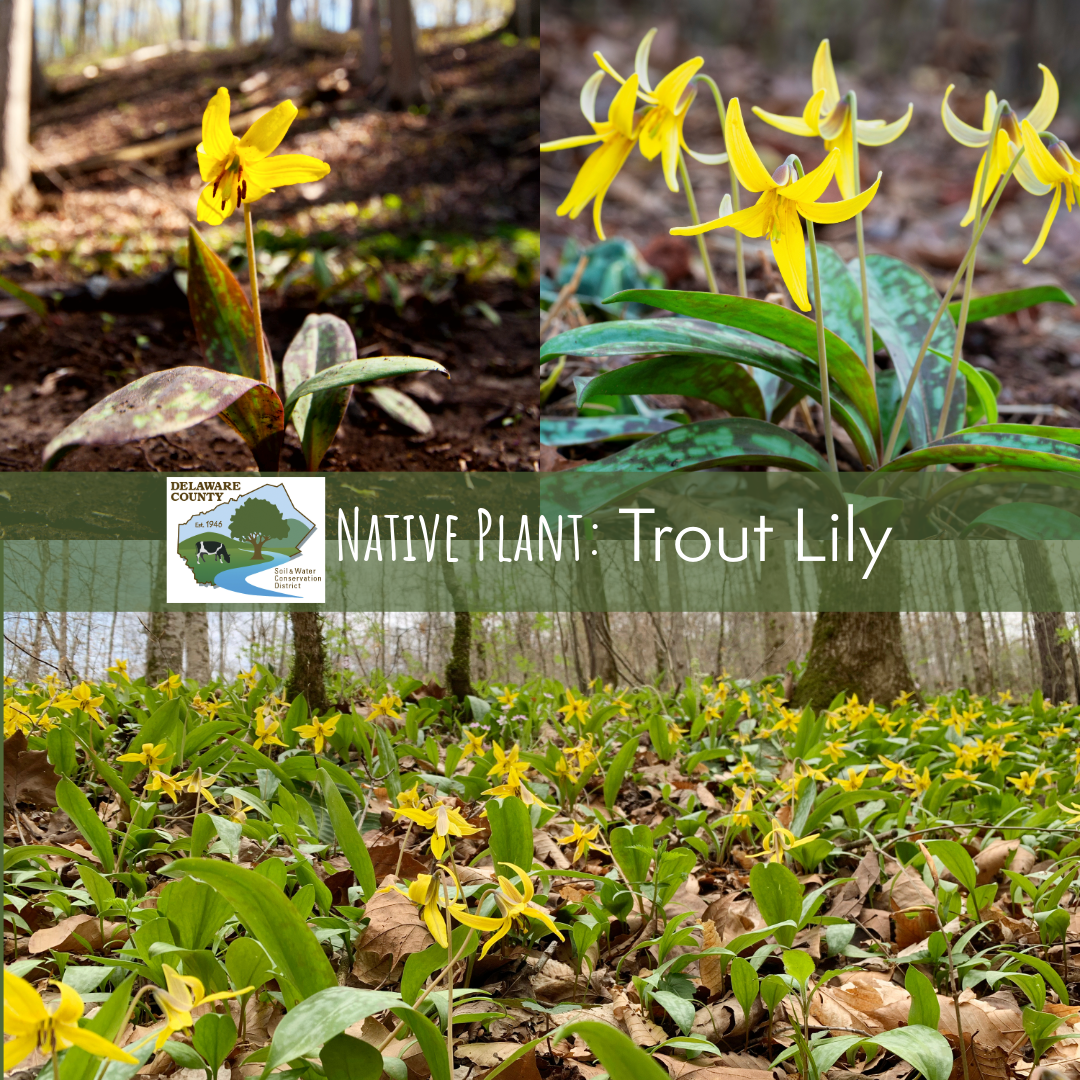
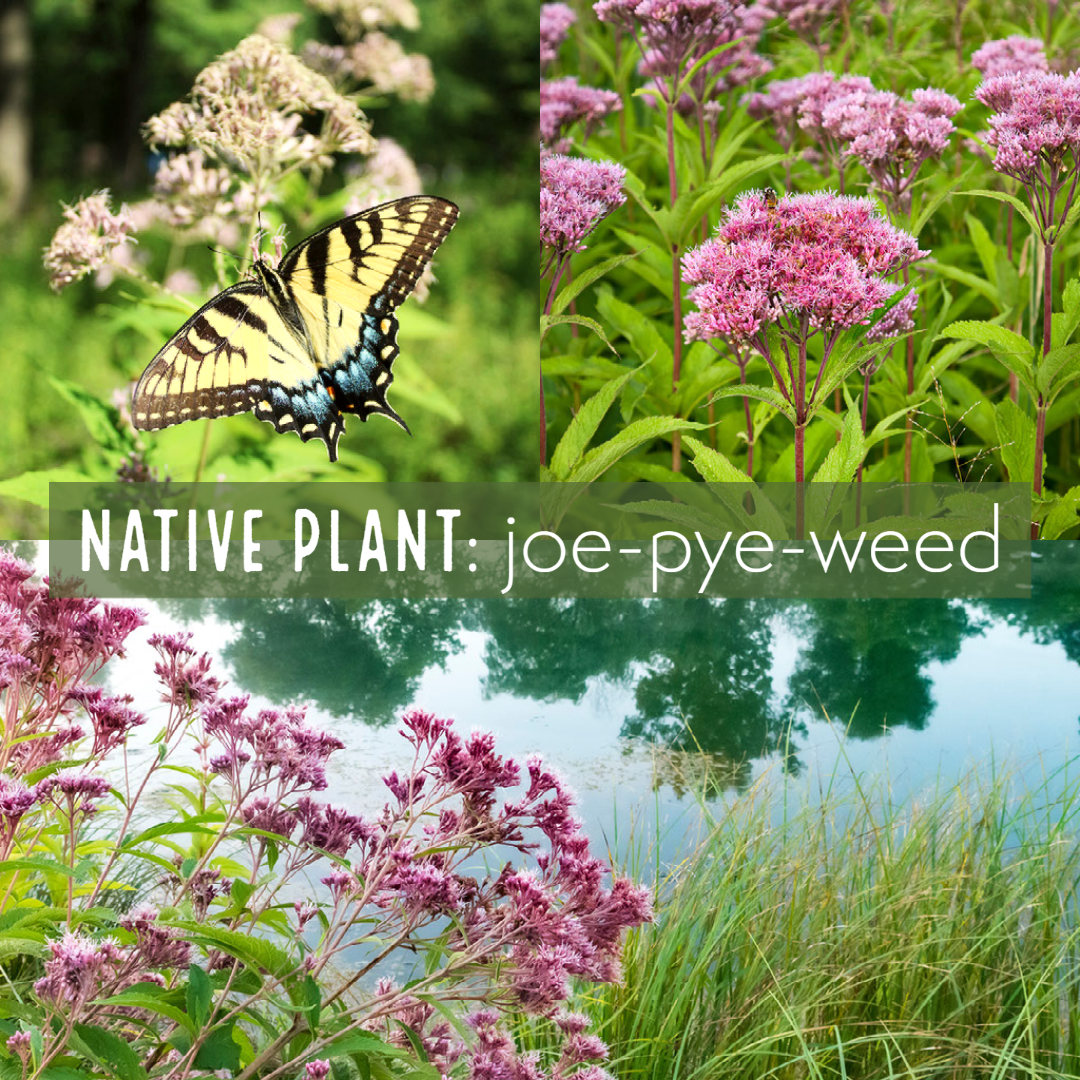
In August, look for Eutrochium maculatum’s purple clustered blooms rising 4-7 feet high from moist, fertile, humus-rich soils. Also known as Joe-Pye-Weed or Spotted Joe-Pye-Weed, the native perennial blooms mid-summer through early fall on tall stems with serrated, lance-shaped green leaves. Deer-resistant, Joe-Pye-Weed’s fragrant blooms do attract pollinators including Eastern tiger swallowtail and black swallowtail butterflies, bees, and hummingbirds. These insects attract insectivorous birds, while in the fall, the clustered blooms produce seeds which provide food for the American Goldfinch and other birds and small mammals.
While preferring full sun, Joe-Pye-Weed’s preference for wet spaces makes it a great addition to areas that many landscaping plants do not tolerate, including rain gardens. The plant’s fibrous and rhizomatous roots aid in reducing soil erosion and help the plant spread into colonies that can be divided and replanted.
Witch Hazel (Hamamelis virginiana) is a unique, small, shrub or tree that is native to the Midwest and Eastern United States. Reaching only about 15 feet tall, witch hazel prefers part to full shade in moist woods, thickets, and bottomland sites – look along the edges of woods and in the understory for its delicate flowers. These fragrant, bright yellow, ribbon-like flowers bloom in fall, displaying strap-like, crumpled petals that persist after golden-yellow fall foliage drops. The flowers provide an important source of seasonal nectar for the Owlet moth and other pollinators.
Witch hazel’s velvety fruits from last year’s flowers appear alongside this year’s blooms and are a food source for birds, including wild turkeys, and small mammals. The plants are also browsed by deer and beaver. Witch hazel makes a striking addition to shady home gardens, especially while most other plants wind down in the fall.
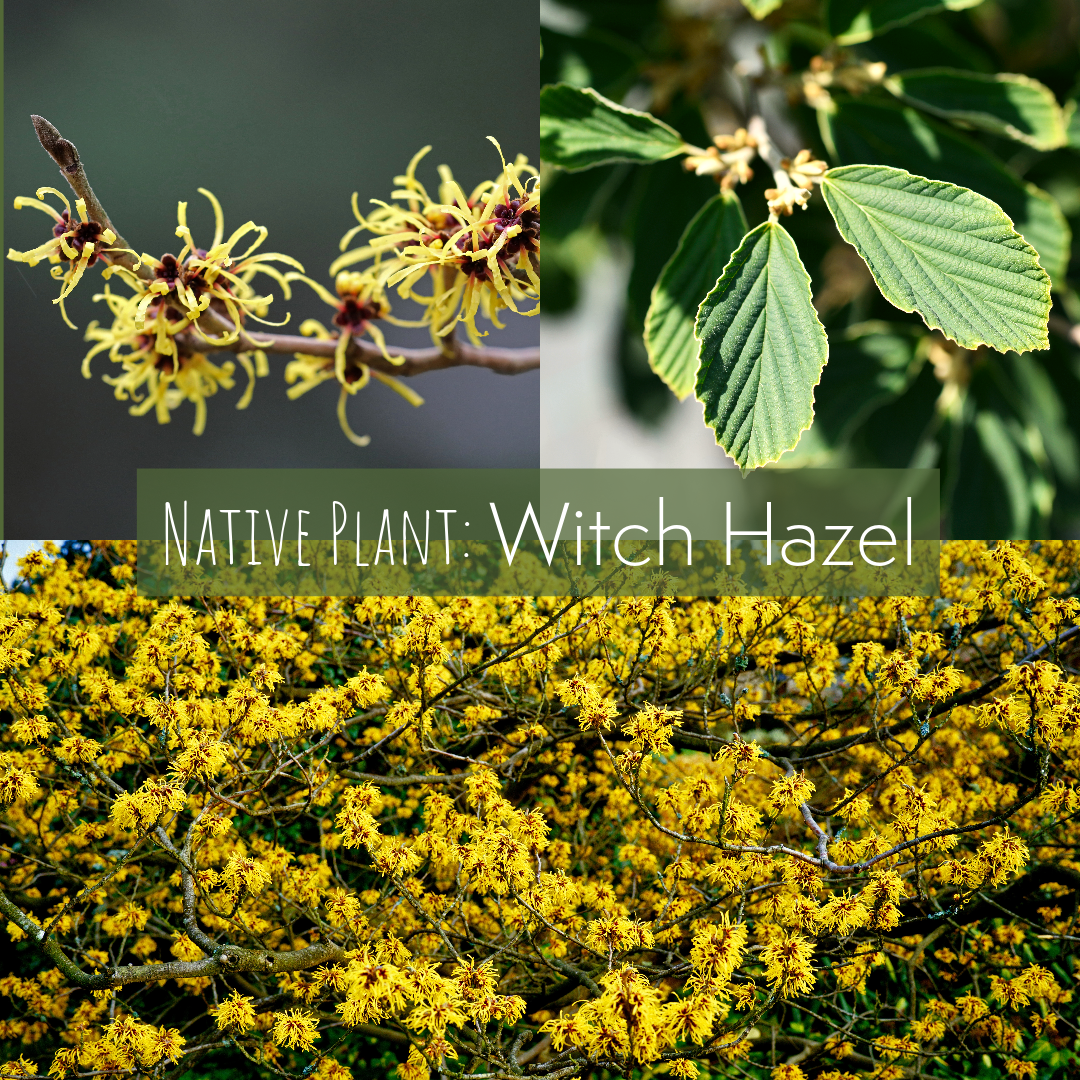
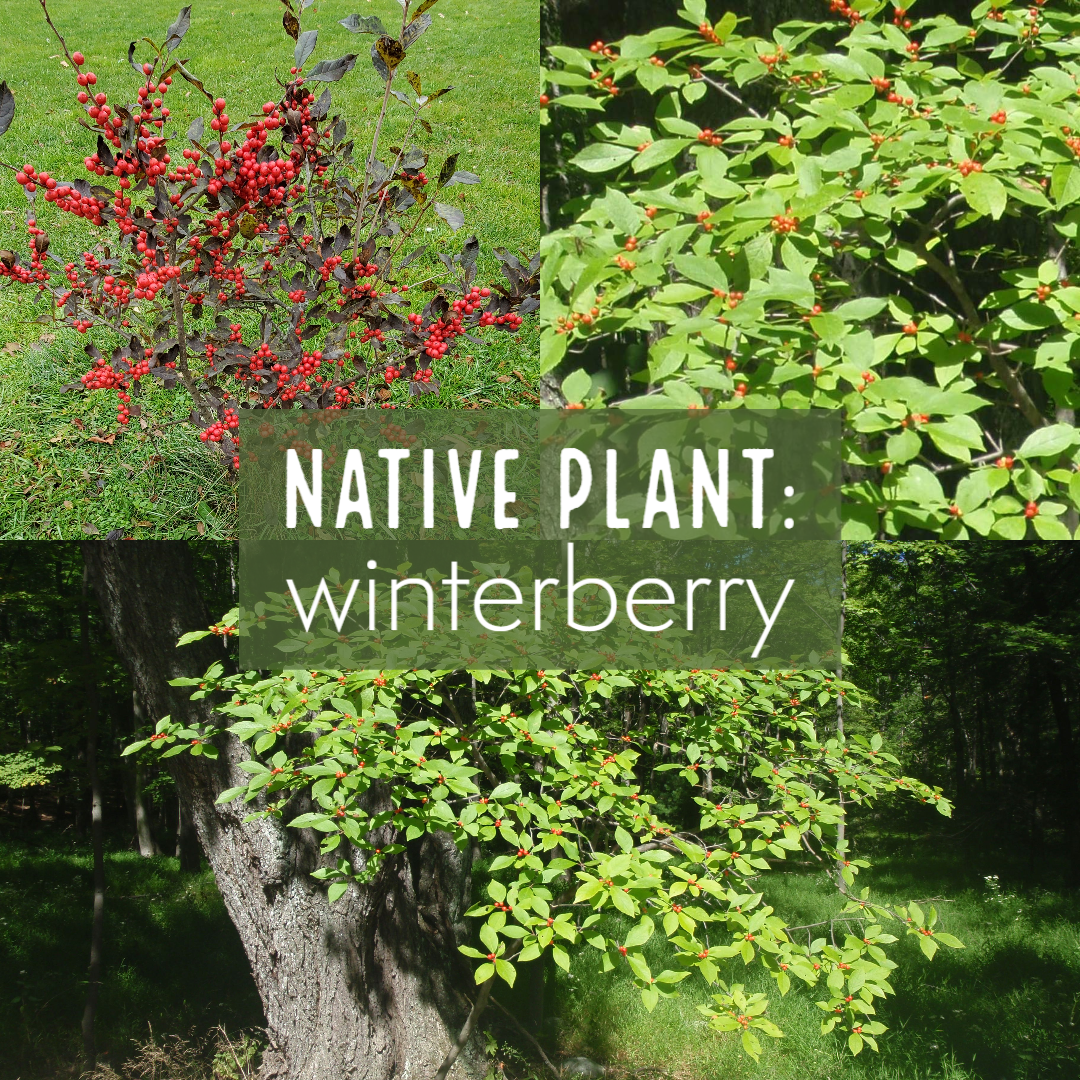
Our region is home to a native deciduous holly, Ilex verticillata. Winterberry thrives at the edge of water bodies and throughout riparian areas, which are abundant in Delaware County, and prefers partial sun to full shade – an ideal plant for those growing areas that other plants may find difficult. And, even in the depths of January, the shrub’s bright red berries hang on throughout the month providing a vital food source for small mammals and OVER 48 SPECIES OF BIRDS! Though winterberry fruit is a food source for some wildlife, it contains saponins and can be poisonous to pets and people if eaten in quantity.
The native winterberry is an ideal landscaping plant that is both aesthetically pleasing and beneficial to wildlife. If you’re looking to add some color to your winter garden, native winterberry makes a great choice over similar invasive species, such as Japanese barberry or exotic honeysuckles.
Iris versicolor, commonly known as the Northern Blue Flag Iris, Dagger Flower, or Harlequin Blueflag, is a beautiful native iris that thrives in high-moisture areas such as along the water’s edge, wetlands, bogs, water gardens, and areas with standing water. Blooming in summertime, its deep blue to purple flowers with yellow centers attract hummingbirds and butterflies as well as many other pollinators, especially our native bees.
Native to the northeastern US and eastern Canada, hardiness zones 4 to 8, the sword-leaved Blue Flag Iris reaches heights of 18 to 24 inches. While its vibrant blooms add a lovely splash of color to your garden or landscape, be aware that, like other irises, its roots can be toxic to humans and livestock. In New York State, you might also encounter two other similar “Flag” irises: the Southern Blue Flag Iris and the Slender Blue Flag Iris, although they are less common.
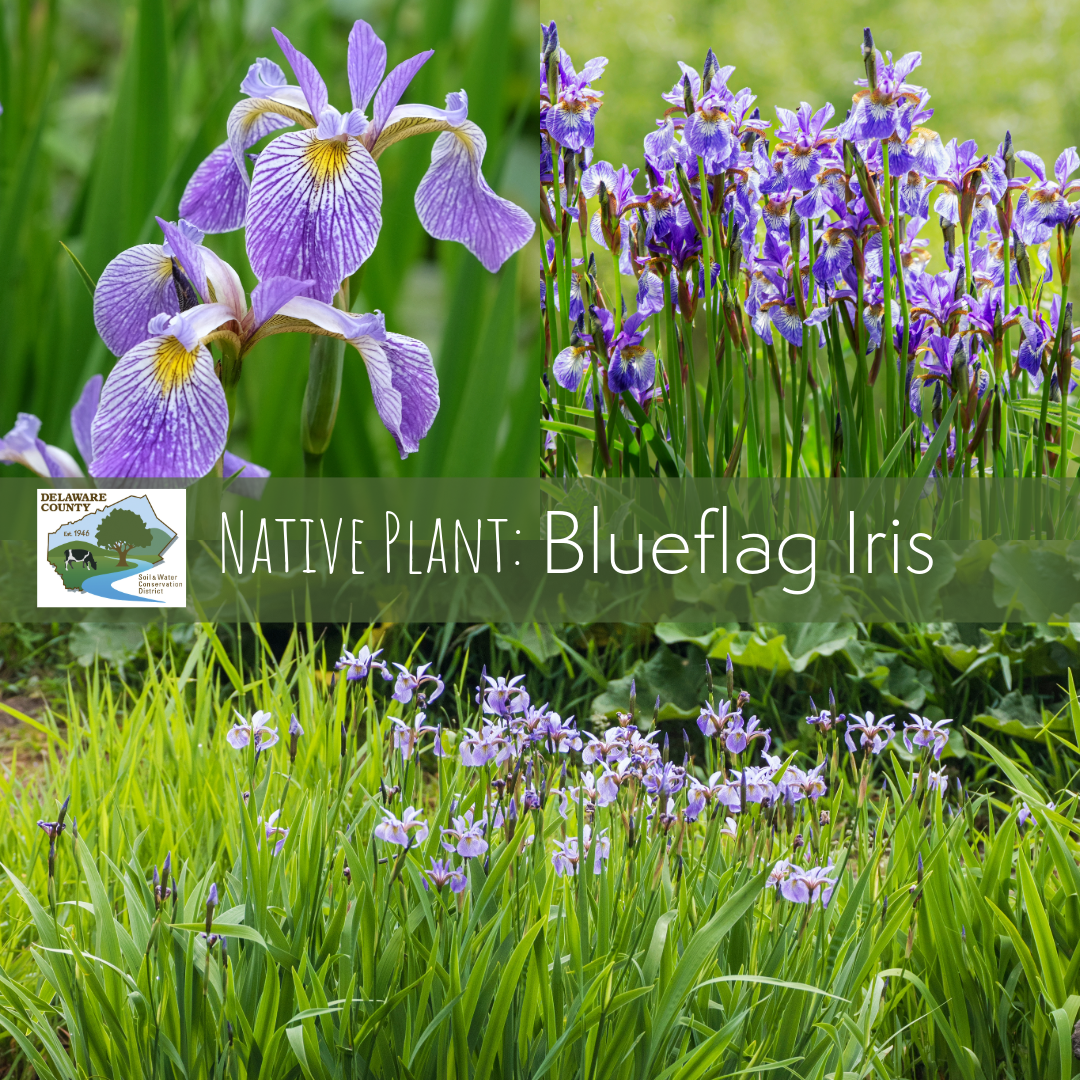
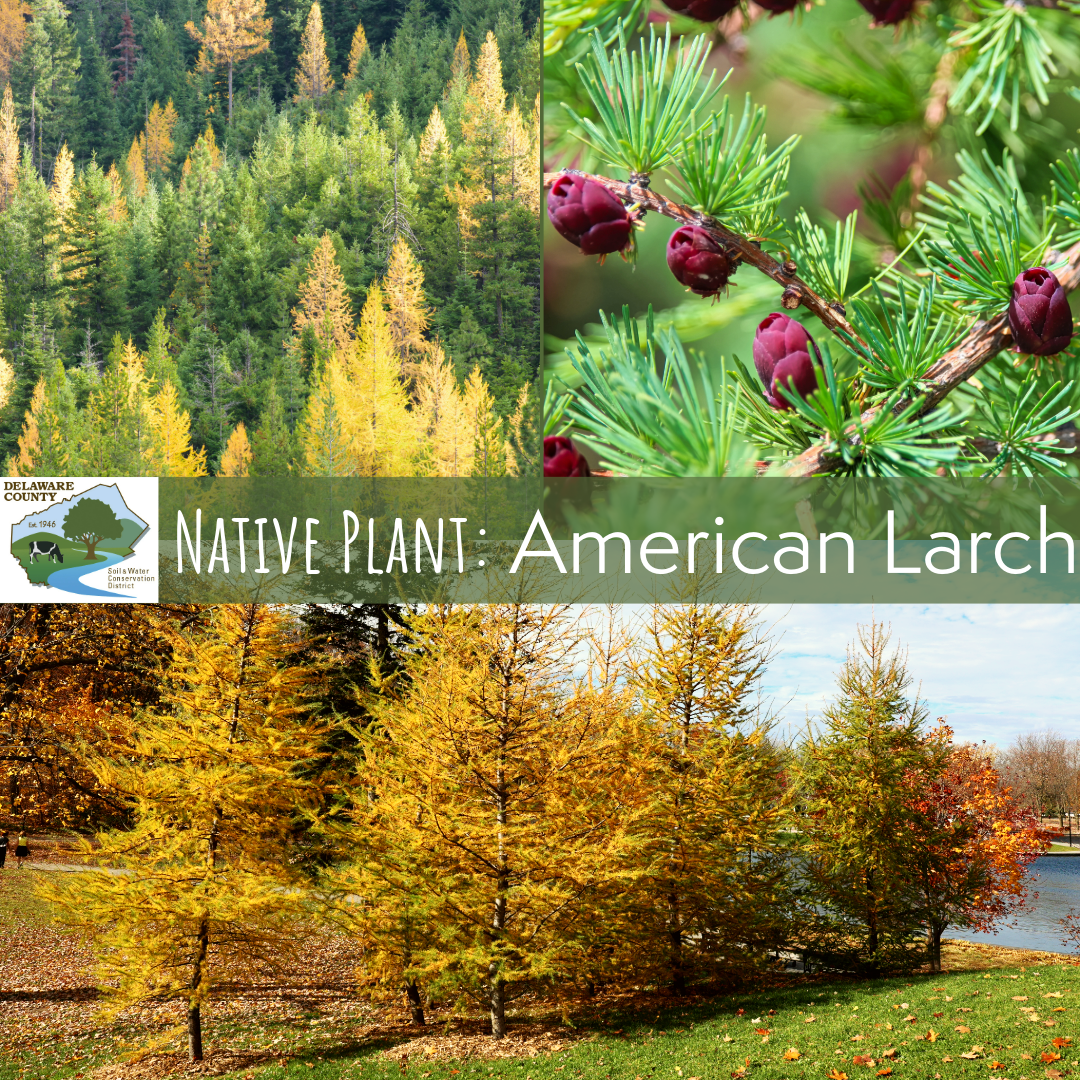
Larix laricina, commonly known as American larch, Eastern larch, tamarack, or hackmatack, is the only New England conifer to drop its needles in the autumn and grow new ones in the spring. In fall, the needles turn golden-yellow and then shed, leaving the tree bare until spring when new, green needles begin to sprout. This hardy tree ranges far north into the tundra regions of Canada, usually found in wetlands, but occasionally in non-wetlands, preferring boreal forests and wet, poorly drained bogs and woodlands.
One of the fastest growing conifers, American larch thrives in full sun and temperate to sub-arctic climates, reaching up to 80 feet in height. Valuable to wildlife, American larch seeds, seedlings, and bark provide food for a variety of bird and mammal species while its physical structure provides nesting habitat. The tree’s growing niche, seed germination niche, and deciduous nature make it a particularly unique native species.
Native Americans of northern New England and Canada used the roots of tamarack for stitching together birch-bark canoes, as the terpenes in tamarack wood make it very durable when wet. Other uses include rough lumber, railroad ties, and poles and pulp products.
When June arrives, you may get a glimpse of the native Tulip Tree, (also called tulip poplar, or yellow poplar, Liriodendron tulipifera, in bloom. The showy, yellow flowers with orange bands produce abundant nectar and pollen and attract hummingbirds which are returning from their winter migration sites, as well as numerous pollinators, including both native bees and honeybees, which can be hidden amongst the lobed leaves. The flowers develop into cone-like green or brown fruits that contain numerous winged seeds later in the season attracting small mammals and birds. Young trees may also provide food for rabbits which eat the buds and inner bark.
One of the largest native trees in North America, its range stretches across the central and eastern United States, up into southern Ontario. Preferring moist, well-drained soil, full sun, and slightly acidic soil, trees can reach heights of 200 feet with a trunk diameter of 8 to 10 feet. A great focal point for landscapes, the trees are grand and have showy yellow leaves in fall.
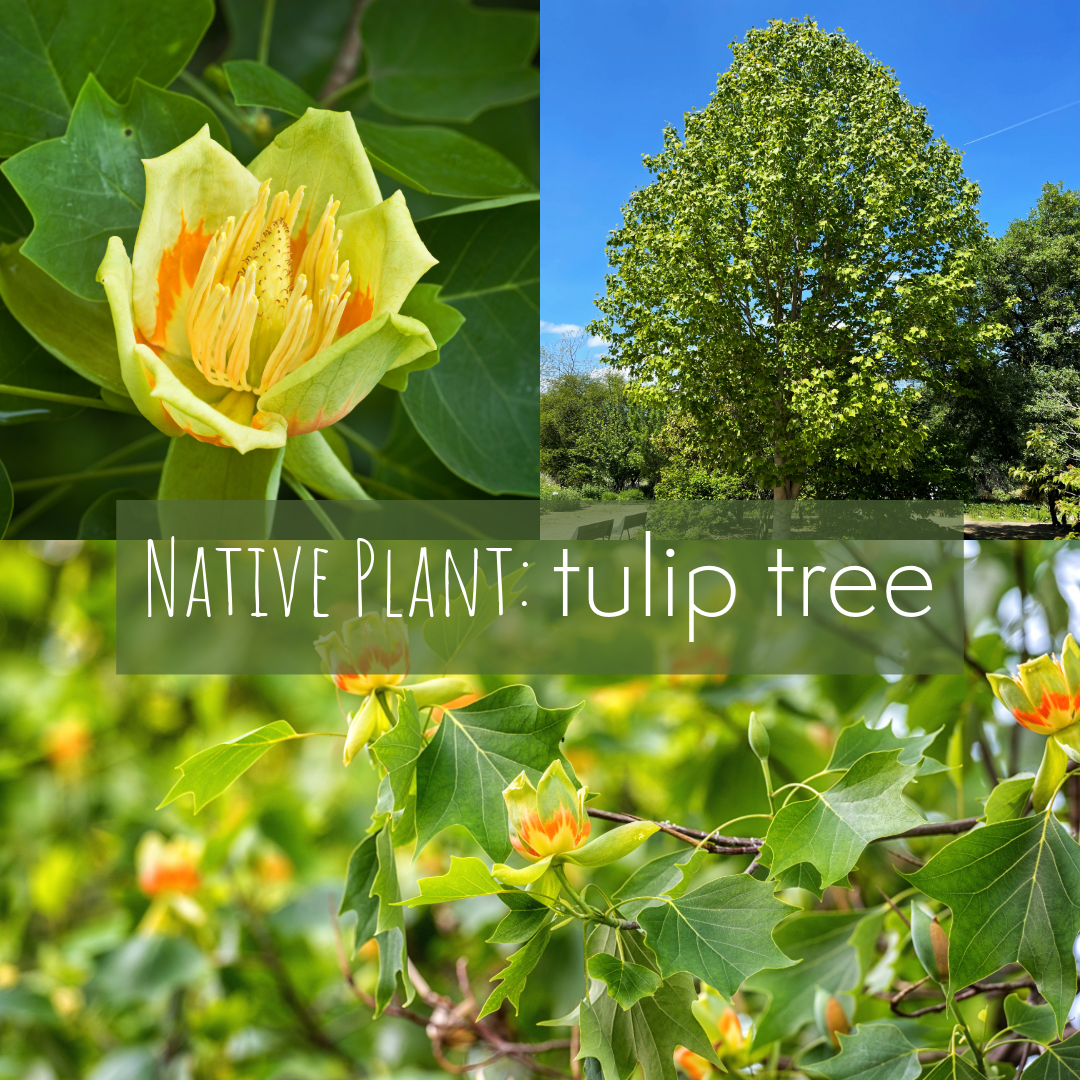
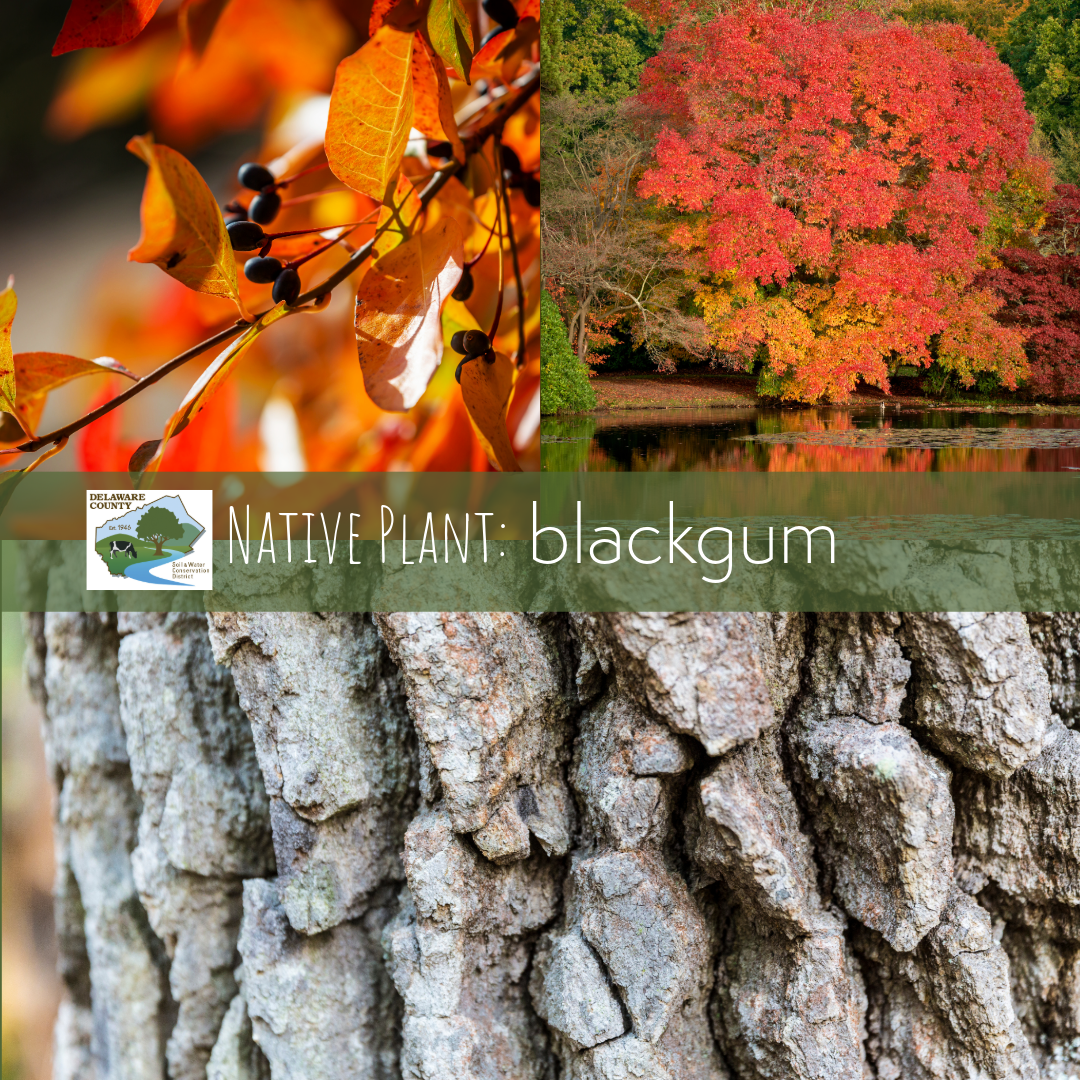
Blackgum (Nyssa sylvatica), also referred to as Black Tupelo, is a tree native to the central and eastern United States. Preferring full to partial sun, the tall trees can reach heights of 80 feet. This tree is among the most shade tolerant of tree species, blooming from May to June, and tolerates clay and wet soils. Blackgum is found in hardiness zones 4 to 9. In the southern part of its range Balckgum overlaps with, and is often replaced by Swamp- and Water Tupelo (N. biflora and N. aquatica), especially in the wetter sites.
The small blooms are an excellent nectar source for bees, while the small, dark blue fruits that follow are eaten by birds and other wildlife and are a good source of crude fat, fiber, phosphorous, and calcium.
Blackgum is a great choice for landscaping as a shade tree, street tree, or as an addition to naturalized areas that tend to periodically flood. It tends to be easy to grow and establish and can tolerate a wide range of growing conditions. Gorgeous fall colors of vibrant reds, oranges, and burgundy burst across the landscape from the tree’s alligator skin-like bark, adding color and interest to any area.
Eastern white pine (Pinus strobus)’s range stretches across the Eastern U.S. into Canada, preferring full to partial sun in riparian and upland sites. White pine trees can be seen in a wide variety of habitats from dry rocky forests to edges of wetland. This species provides an important winter habitat for non-migrating birds, including the Barred Owl, woodpeckers (especially the impressive Pileated woodpecker), tufted titmouse, chickadees, goldfinch, and others. The tree’s seeds are eaten by many birds and small mammals, while black bear mothers and cubs utilize large trees for climbing and safety – be sure to look up!
In early winter, you may see yellow needles dropping to the ground, adding to the mulch, and creating new soil as they decompose. This is a natural process for the trees which shed some of their older needles to save energy for new spring growth. This also reduces the load on the tree during heavy spring snows. White pine can be identified by the number of long (3 to 5 inch) soft clusters of needles. White pine has five needles in a bundle, whereas other pine species have them in bundles of three. The cones, which are often used for decoration, hang from branches and can be from 5 to nearly 10 inches long.
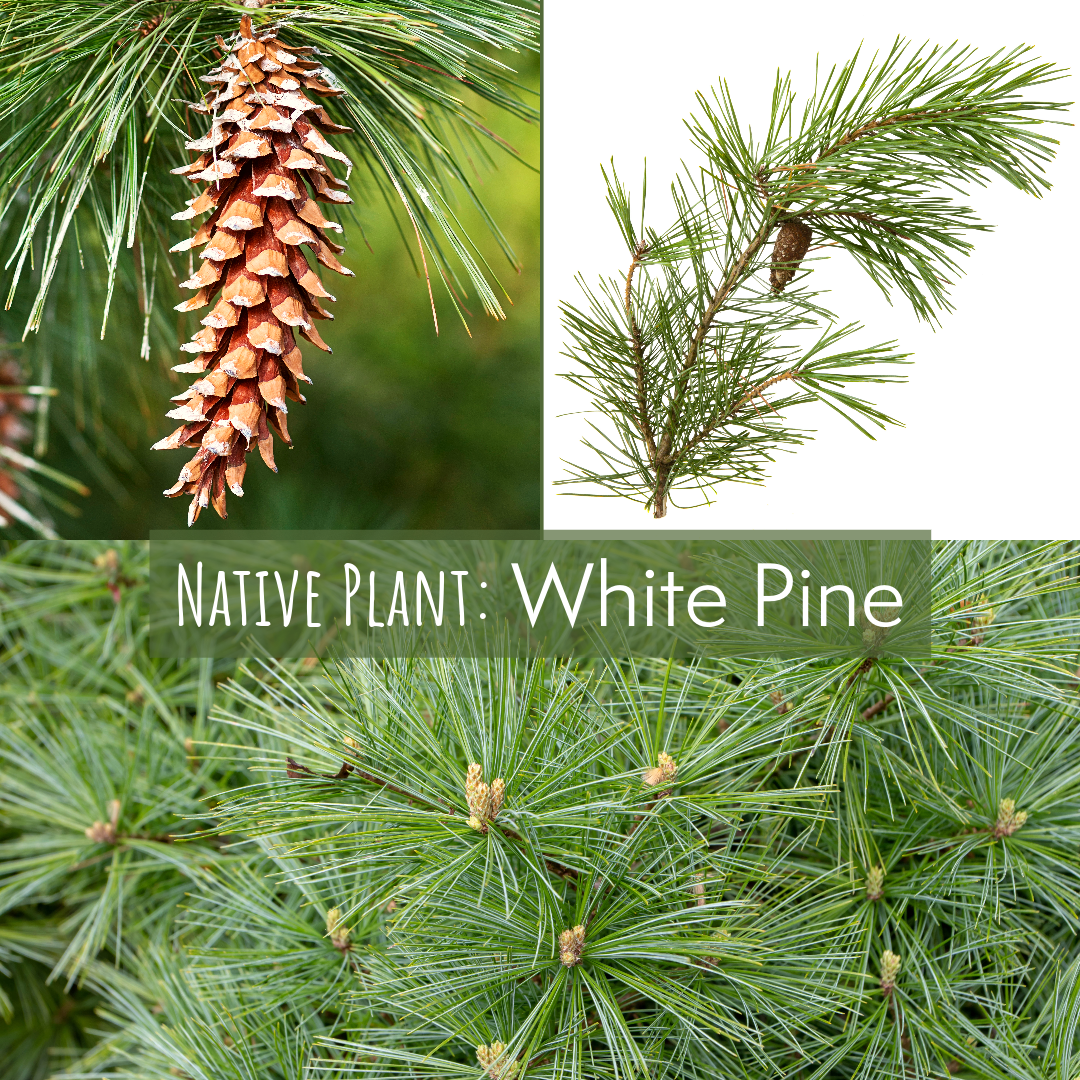
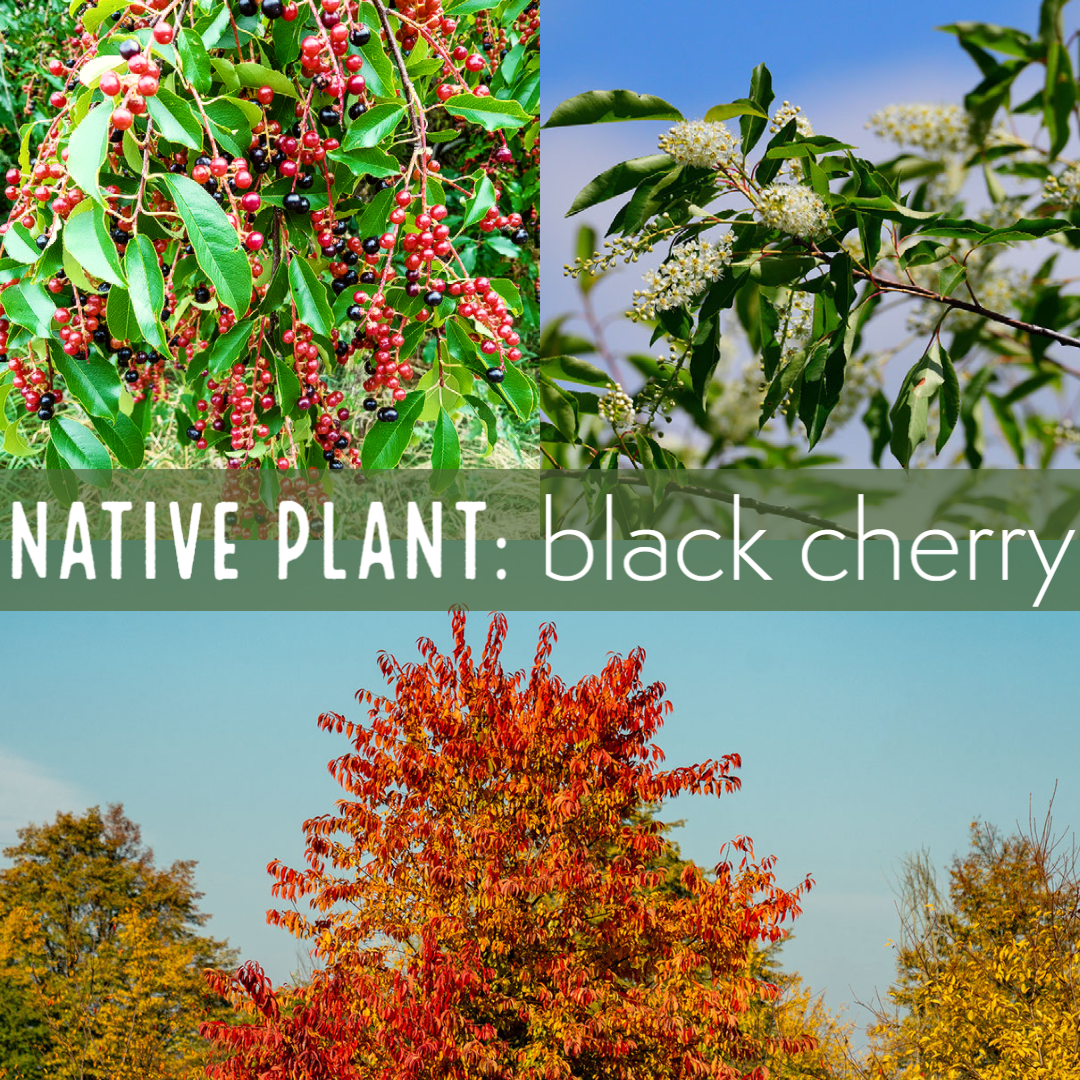
The first month of summer does not disappoint with the native plants coming out in full force across the Catskills. This June look for Prunus serotina, aka Black Cherry / Rum Cherry / Mountain Black Cherry blooming in full to partial sun. The wildlife value of Black Cherry is high for pollinators, birds, and mammals. Its flower nectar attracts bees, butterflies and birds and the fruit is eaten by many species including birds, red fox, black bear, raccoon, opossum, squirrels, and rabbits.
Black Cherry towers over many species, reaching heights upwards of 80 feet across zones 3 to 9. Preferring moist or dry open woods and old fields, the species can be found in thickets, woodlands, canyons, floodplains, and lower riparian slopes across Central and Eastern US and Canada.
If you have space for a large, long-lived tree, Prunus serotina is a valuable native addition for landscapes and woodlots.
Quercus bicolor, or swamp white oak, is native to central/eastern North America and can be found in swamps, riparian forests, floodplains, and forest edges. Trees can reach 60-80’ tall and live 300-350 years, beginning acorn production when 20-30 years old.
The swamp white oak has high wildlife value. Numerous insects, including various species of leafhoppers, aphids, beetles, and moths feed on the trees, while the trees are also host to early life stages of these insects as well as butterfly caterpillars. Birds, including songbirds, woodpeckers, ducks, turkey, and other game birds, consume the trees’ acorns and the insects that the trees attract. Mammals such as black bears, raccoon, deer, mice, and squirrels also consume the trees’ acorns.
While an important food source, the large, long-lived trees also provide habitat amongst its limbs, leaves, and bark for insects, birds, and mammals as well as lichen. Fallen trees continue to support organisms such as insects and fungi as both a food source and habitat.
These trees make interesting additions to the landscape and can also help to reduce erosion with their shallow, wide-spread root systems. Their branches also help to shade rivers, streams, and other bodies of water which can be beneficial for various aquatic species. Preferring full sun and wet conditions, swamp white oaks can be planted where many other species of trees would not survive.
Images: Robert H. Mohlenbrock., Steve Hurst, J.F. Clark: USDA-NRCS PLANTS Database
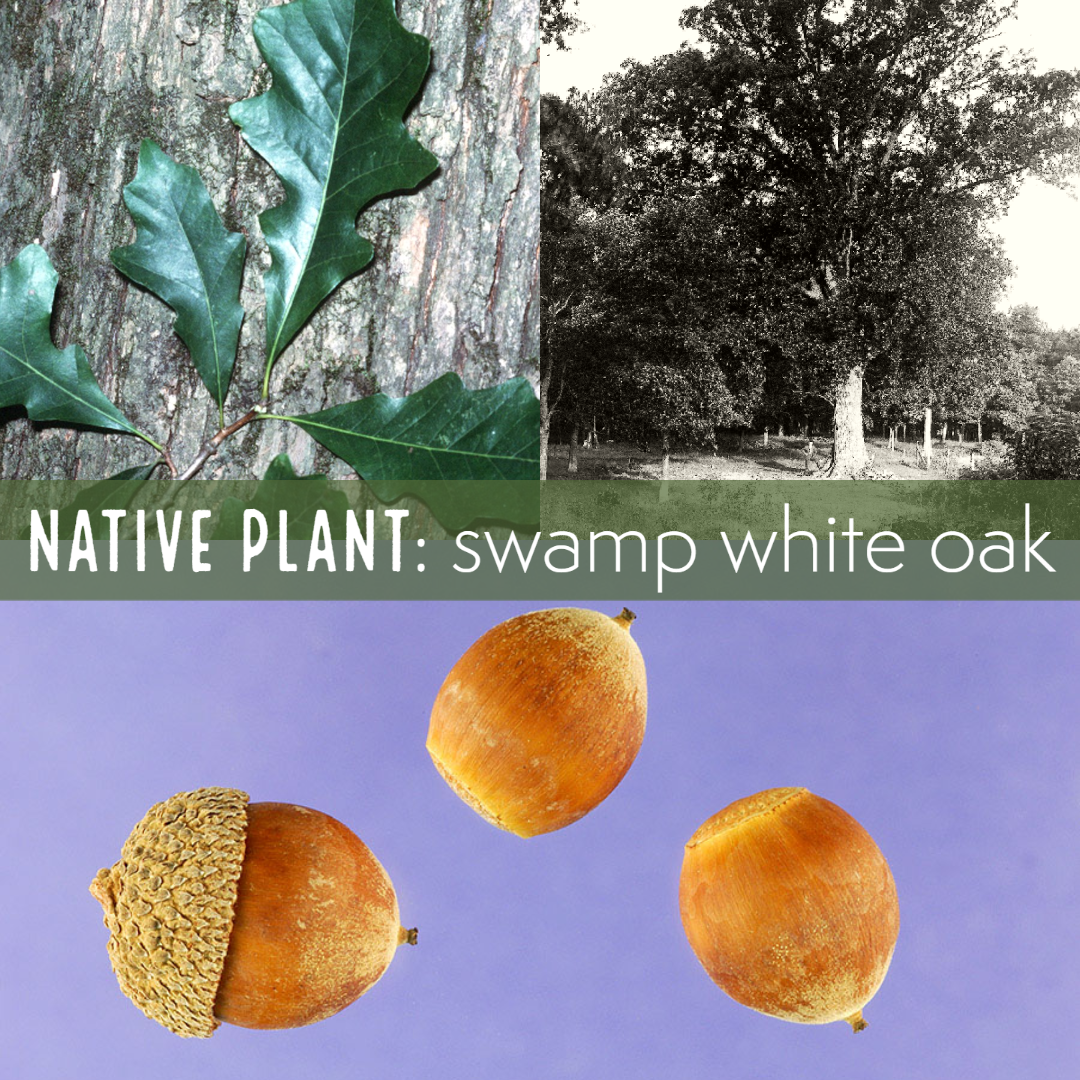
Quercus rubra’s, Northern Red Oak, native territory spreads from the mid-west through the northern and eastern U.S., zones 4 to 8, dominating forests by both size and abundance. One of the most shade-tolerant oaks, it thrives in mesic upland forests, ravines and north and east slopes preferring acidic soils.
Blooming in spring, the northern red oak is a nectar source and larval host for the Gray Hairstreak butterfly. Blooms give way to acorns that provide a major food source for birds and small and large mammals – including squirrels! Its fall color can be crimson, golden-orange, or russet, creating striking shows of color across its habitat range. As the northernmost eastern oak, “the great timber tree” is the most important lumber species of red oak, used for flooring, furniture, millwork, railroad crossties, mine timbers, fence posts, piling, pulpwood, and more.
April is a great month to get out into your local landscape as spring blooms start to emerge and pollinators become more active. An early and important nectar source are native willow species which include Salix discolor, or pussy willow, which has one of the most recognizable blooms of the willow species. The furry catkins, or flowers, cover the pussy willow shrub or small tree which also provides valuable habitat and food for songbirds, waterfowl, insects, and small mammals in addition to the early pollinators. The native perennial flourishes on the edges of rivers and lakes and in shrublands, thickets, swamps, ditches, and edges of wetlands with moist soil conditions.
In New York State, there are more than 15 native willow species, ranging in size from low shrubs to 90+ foot trees. Found frequently on the edges of wetlands and streams, willows’ expansive root systems reduce erosion as they hold large amounts of soil in place and intercept and filter sediments during flood events. The medium to large tree species also help to shade waterways during the summer with their broad, irregular canopies which also help to regulate water temperatures.
Occurring throughout the US and Canada, elderberry, Sambucus nigra, (aka Common elderberry, Black elderberry, American elder) is a native plant that is an important habitat and food source for wildlife. Its dark berries that ripen in early fall are preceded by lovely white clusters of summer blooms that attract bees, butterflies, and other pollinators. Elderberry flowers are an excellent source of nectar for pollinators and other beneficial insects. Its berries are also an important food source that are eaten by many birds and small mammals.
A moderately sized bush, elderberry grows 3-12 feet making it a good option for privacy borders along a pond, stream, or drainage trough as well as creating riparian buffers and adding diversity to the landscape. It grows best in full to part sun in moist upland sites, on the water’s edge bordering streams and adjacent bottomlands since it requires consistently moist soil.
White Meadowsweet (Spiraea alba) is a wildflower native to the upper midwestern region through the northeastern region of the U.S. The three- to four-foot-tall shrub prefers wetlands including swamps, marshes, shorelines, and ravines, however, can occasionally be found in non-wetlands. Blooming in mid-summer, small, delicate, white to pale pink flower clusters perch atop unbranched stems attracting pollinators, particularly native butterflies and bees. In the spring, it is a larval host to the Spring Azure butterfly.
White Meadowsweet makes a lovely addition to cottage and rain gardens and along wet property areas such as stream or pond banks. Spiraea alba is a great replacement for the many non-native spirea species and is available at local nurseries.
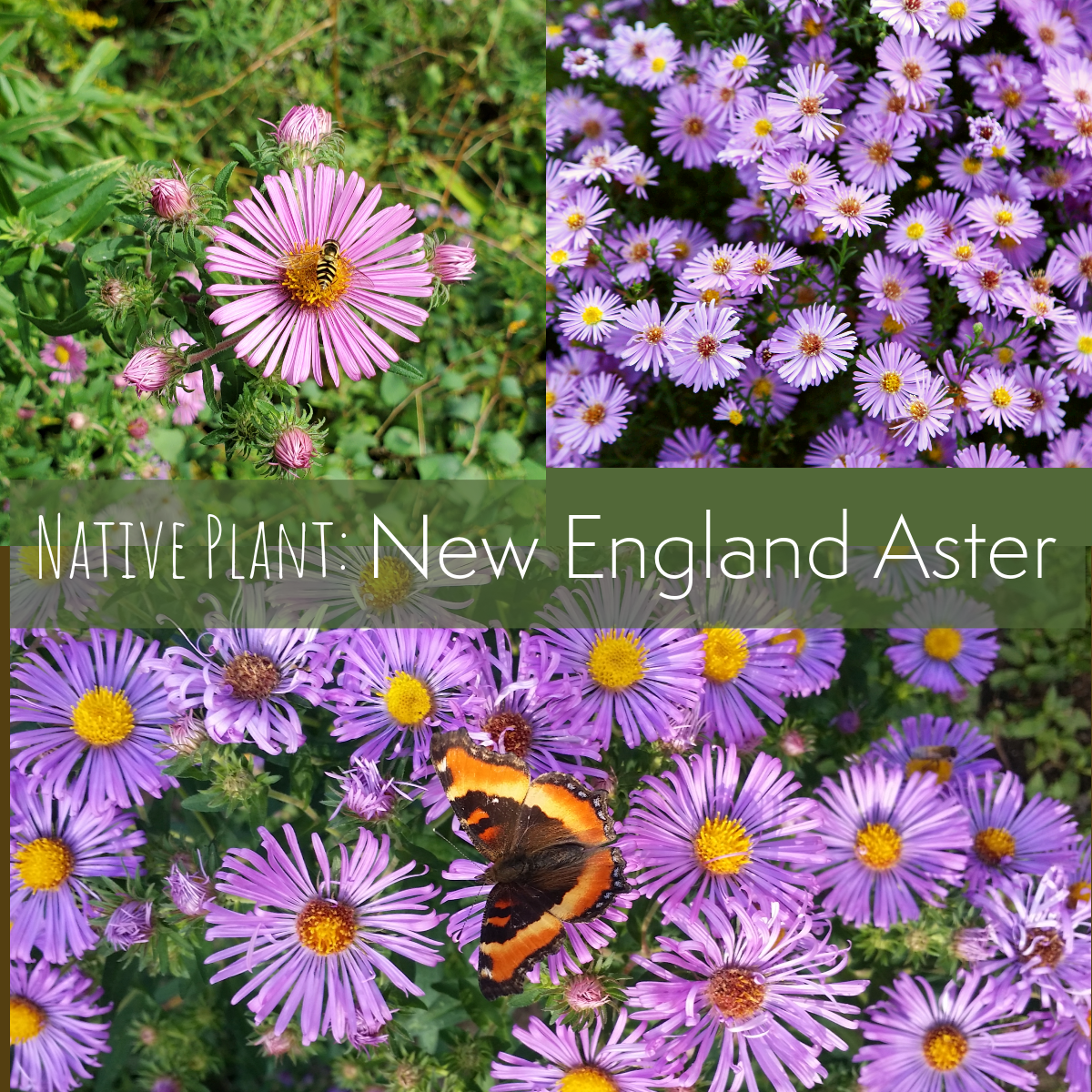
The end of summer is marked by the native Symphyotrichum novae-angliae, or the New England Aster, with its bunched, daisy-like purple or pink flowers dotting roadsides, woodland edges as well as floodplains and meadows. This species is good at supporting a variety of wildlife, especially pollinators. The flowers provide an important source of nectar for Monarchs as they head south, as well as bees and other butterflies. Plants are larval hosts for the Pearl Crescent and Gorgone Checkerspot butterflies, and the Wavy-Lined Emerald moth. As attractive as these showy flowers are to pollinators, this is one of those plants that is not preferred by deer due to its slightly fuzzy foliage, so would be a great choice as a native plant in your garden.
Growing three to six feet high, the New England Aster is commonly used for roadside plantings, restorations, wetland planting, and rain gardens, with a preference for full to partial sun and moist sites.
American Basswood, Tilia americana, has a native range stretching from the Midwest, around the Great Lakes, and up into the northeastern U.S., and even down to Florida. The American Basswood is a fast-growing tree that can reach heights of 140 feet and live for over 200 years. This striking, full-canopied tree is a popular urban shade tree, also known as American Linden, and can tolerate a wide range of moisture conditions and can be found in rich uplands as well as in floodplains.
American Basswood has high wildlife value for a variety of species. It is a host plant to over 160 species of butterflies and moths, including the beautiful Eastern Tiger Swallowtail butterfly. Its fragrant, yellow-white flowers in late spring/early summer attract many other species of insects including bees, flies, and moths. Its abundant nectar is also used by bees to make basswood honey. The flowers are followed by flower bracts, or winged fruits containing seeds, that are consumed by insects, small mammals including rodents, and songbirds. The tree’s bark and saplings are also a food source for rabbits and voles, while its leaves provide a food source for various caterpillars and deer.
While a hardwood species, American Basswood is valued for hand carving, and its inner bark can be used for making rope and weaving. It is also an important lumber tree. When looking for a large, native, wildlife friendly tree, consider planting American Basswood in your landscape.
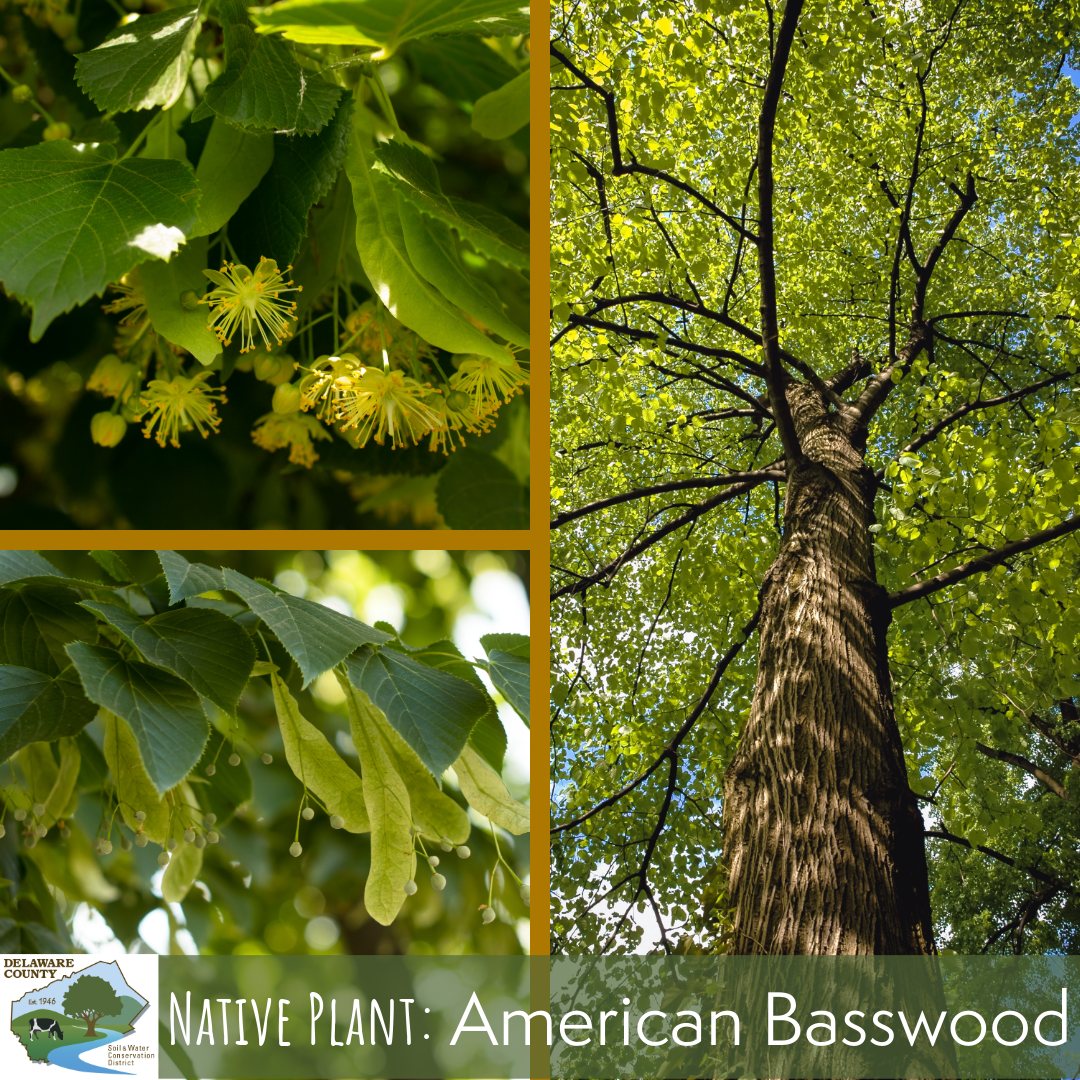
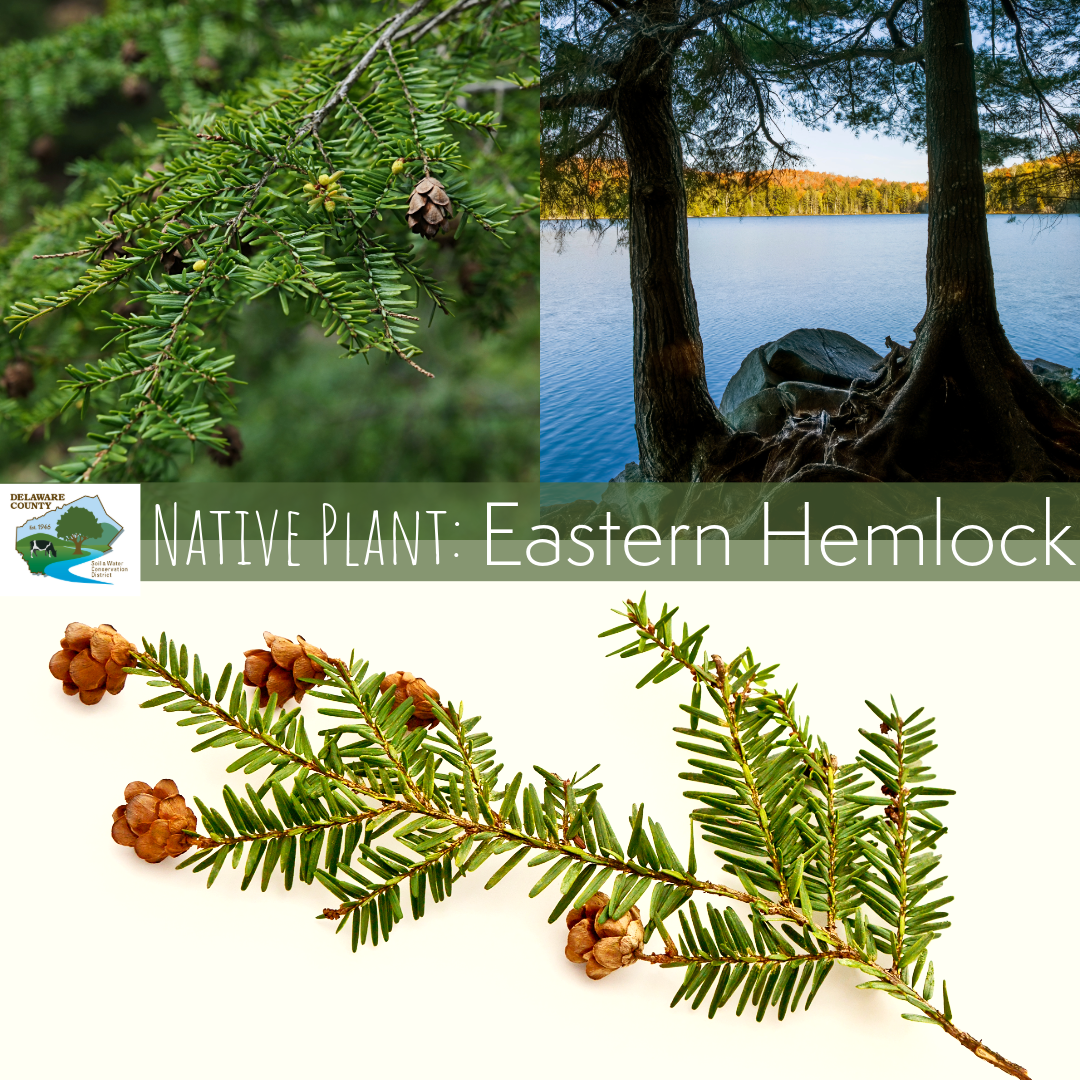
Eastern Hemlock (Tsuga canadensis) is an evergreen tree native to the Northeastern and Central US and Canada that thrives in challenging terrain across plant hardiness zones 2 to 7. This species oftentimes grows on hummocks in swamps where it sometimes forms dense pure stands. Eastern Hemlock also can be found in ravines and on north and east facing lower slopes, as well as rocky outcrops and bluffs. Most commonly, it grows in mixed stands with fellow native species such as white pine, northern red oak, sugar maple, American beech, yellow birch, and white ash.
Eastern Hemlock can reach heights of over 100 feet, preferring acidic soils and partial sun to full shade. Its evergreen boughs provide important shelter and cover for white-tailed deer and other wildlife such as turkey, roughed grouse, and others. The tree blooms in mid-spring with male catkins and female cone flowers which develop into small cones.
In recent years, hemlock populations have been heavily impacted by Hemlock Woolly Adelgid, an invasive pest that is very difficult to contain and treat. As the infestation progresses, tree health declines and mortality usually occurs within four to 10 years. Read more.
Viburnum nudum, also known as Northern Wild Raisin or Possumhaw, is a deciduous shrub native to eastern North America and southeastern Canada. While fairly common in New York State’s swampy and boggy eastern areas, it is listed as endangered in several states, including neighboring Pennsylvania, and is also a plant of special concern in Connecticut. Reaching heights of 15 feet, the shrubs are typically found in wetlands which make them a great option for riparian plantings.
A beautiful native plant, Northern Wild Raisin has clusters of delicate, white flowers in the spring, followed by berry-like fruit clusters in shades of yellow, light rosy-pink, deep rose, and bluish-black. The smooth, deep green leaves provide a glossy backdrop spring through fall.
The plant is host to the Spring Azure Butterfly and Hummingbird Clearwing Moths, and its flowers attract pollinators such as butterflies, bees, and other insects. Ripened berries are consumed by various songbirds, as well as Ruffed Grouse and mammals such as squirrels, chipmunks, rabbits, skunks, and deer which may also use thickets as habitat.
Flower and shrub in landscape photo source: wildadirondacks.org
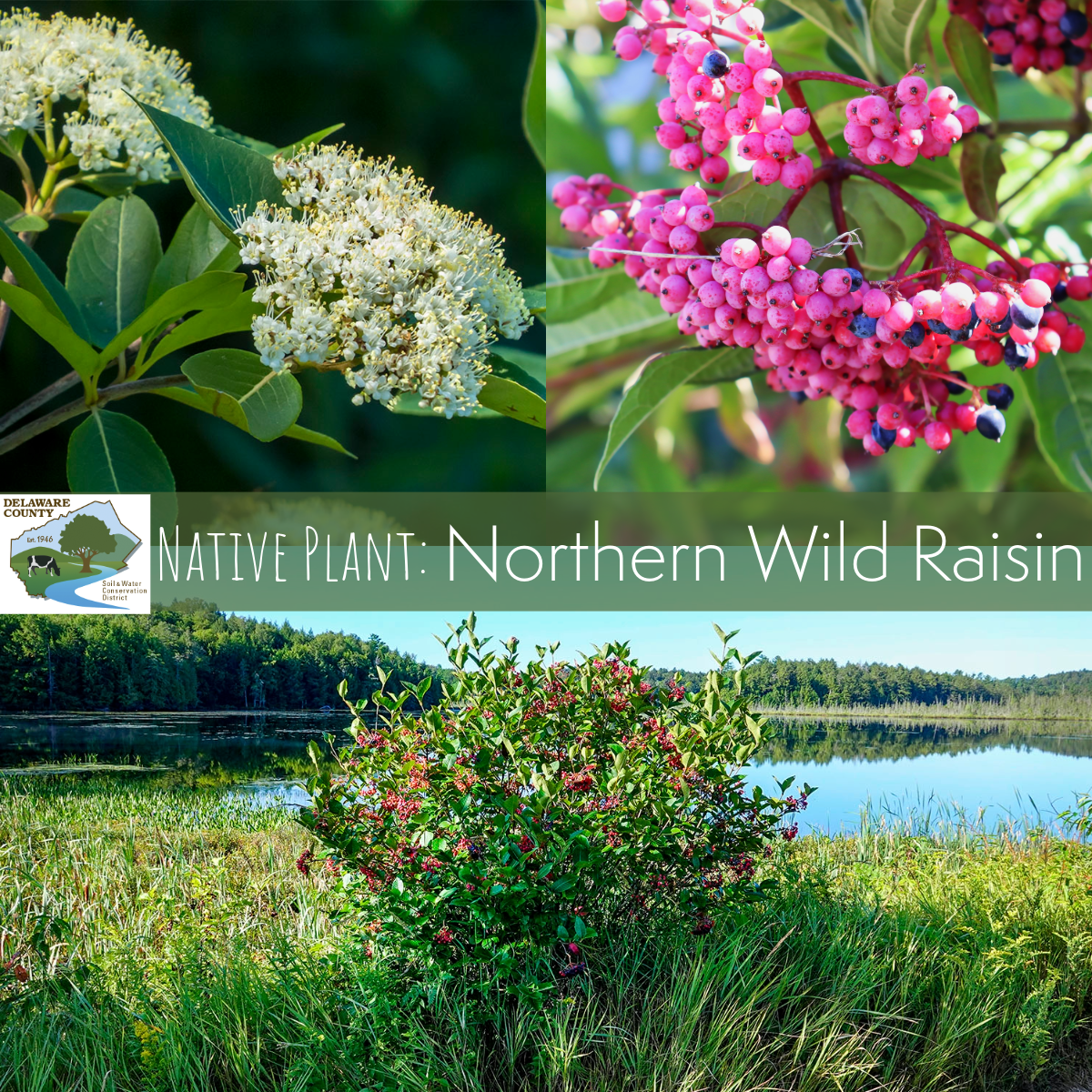
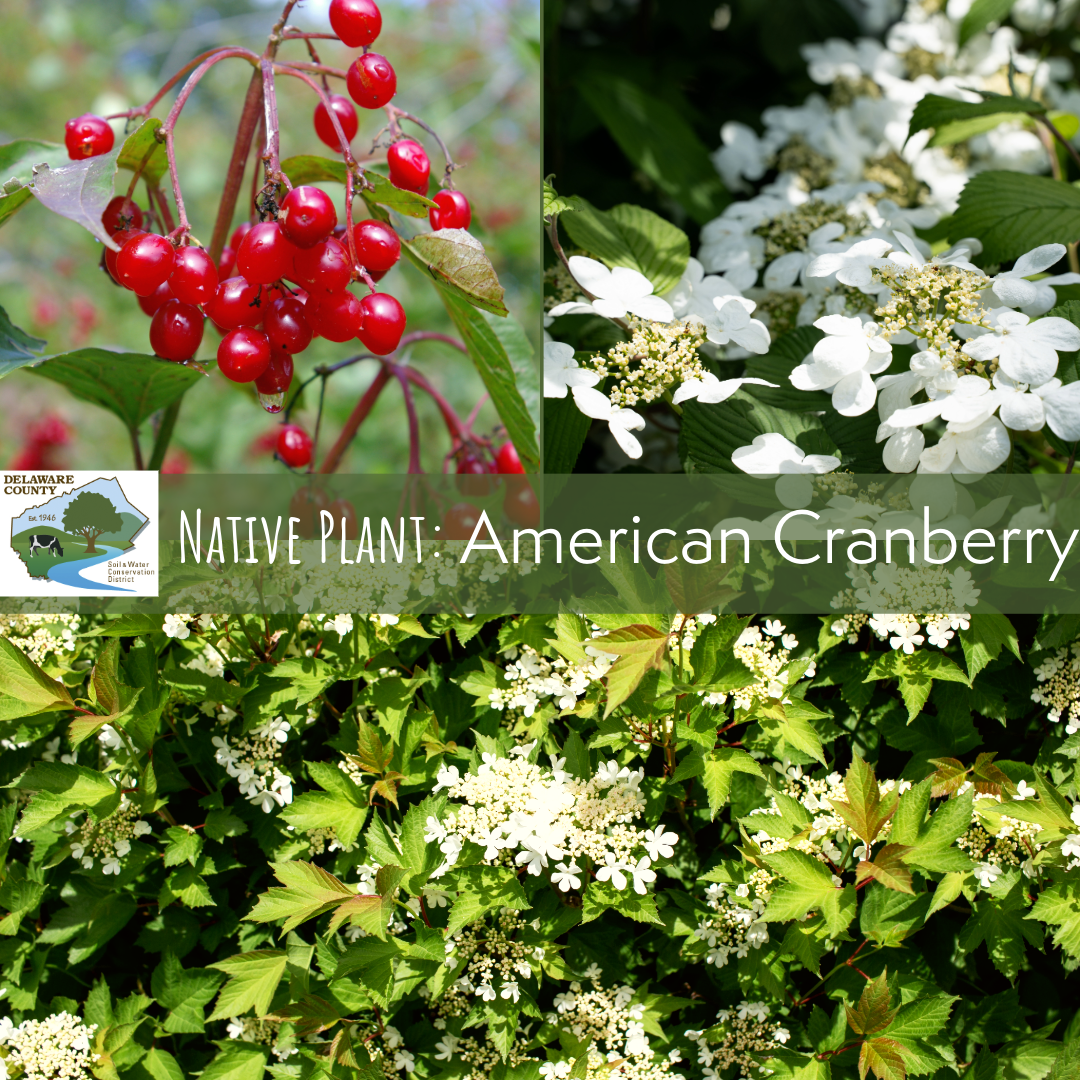
Viburnum trilobum, American Cranberrybush or Highbush Cranberry, is a native flowering shrub that can be found throughout the north temperate region between British Columbia all the way to Newfoundland, south to Washington state and east to northern Virgina. While not a true cranberry, the American Cranberry, produces fruits that both taste and look like cranberries. Its leaves are three-lobed, and look maple-like, hence the name “trilobum”.
This large shrub can grow 8 to 15 feet tall by 8 to 10 feet wide, preferring well-drained, moist, rich, and loamy soils, however, tolerates occasional flooding, road salt, and wet sites. Its dense foliage, stems, and fruit make it an excellent plant for attracting birds and small mammals, and the small clusters of white flowers preceding the fruits attract many pollinators.
American cranberry makes a beautiful landscape plant as it changes with the seasons and can be either grown individually or trained into a hedge or screen with multiple plantings.
The Delaware County Soil and Water Conservation District’s Stream Management Program is dedicated to restoring and stabilizing streams and reducing nonpoint source pollution to ensure quality drinking water, and providing education and outreach on all phases of stream management and stewardship to help stakeholders make informed science-based management decisions.